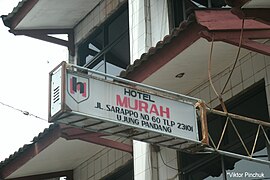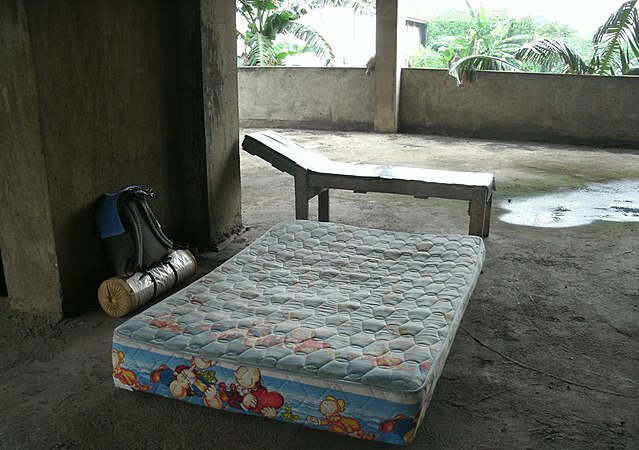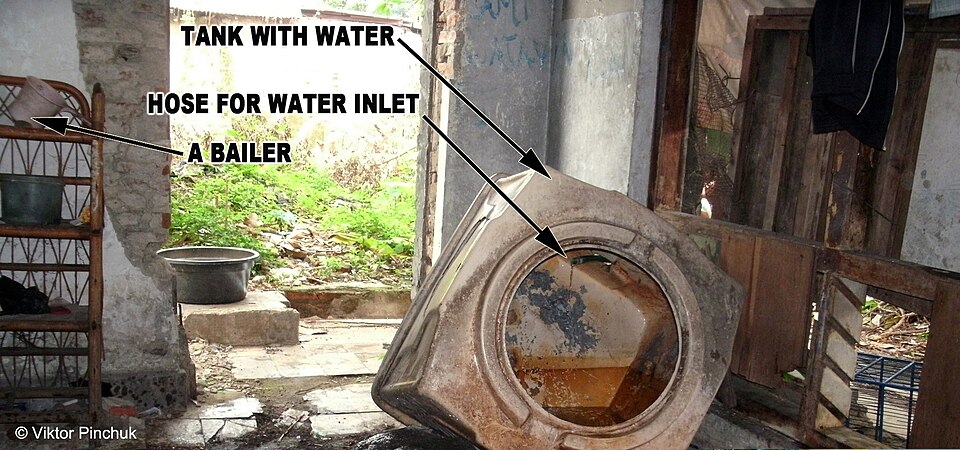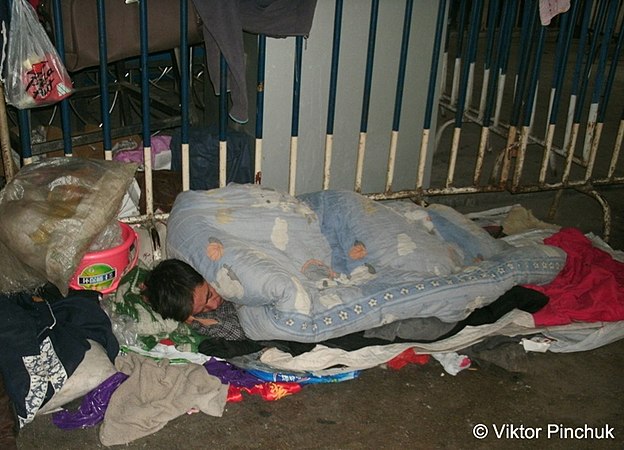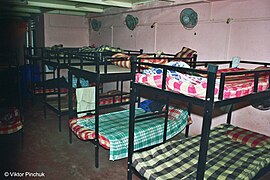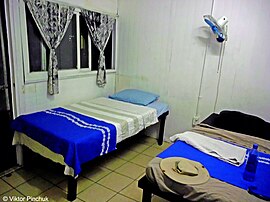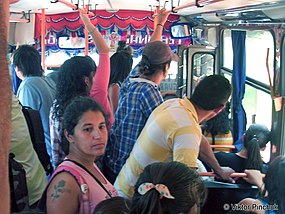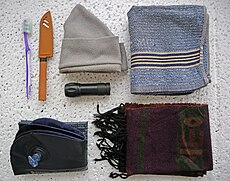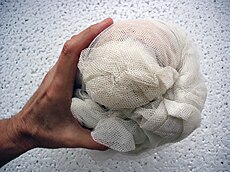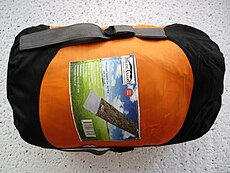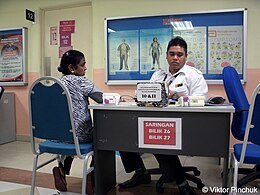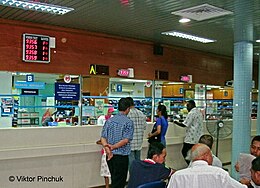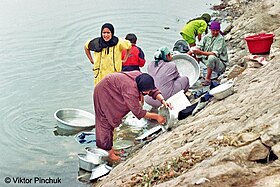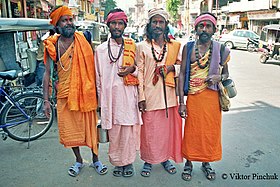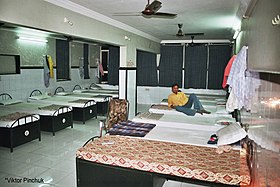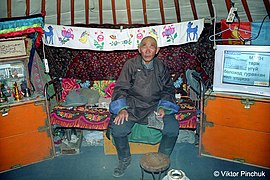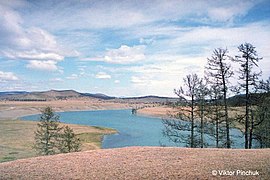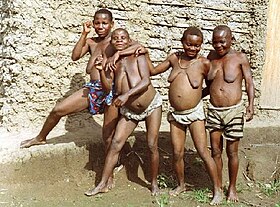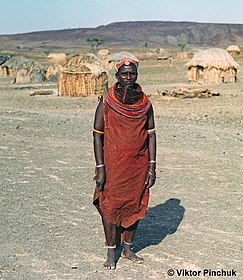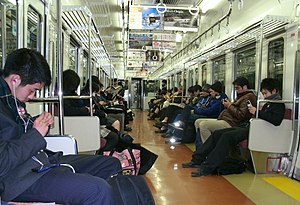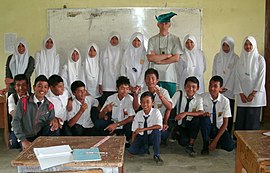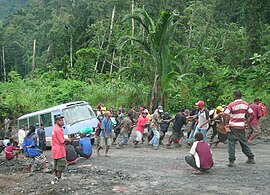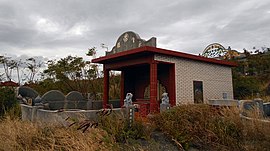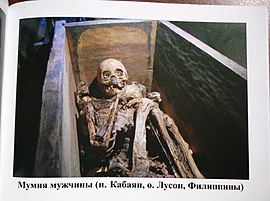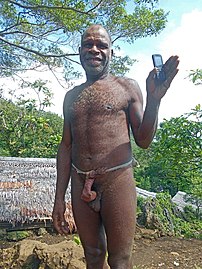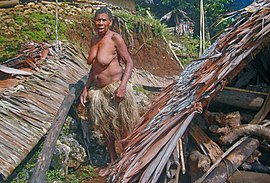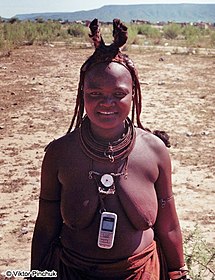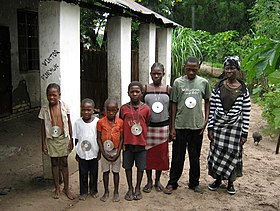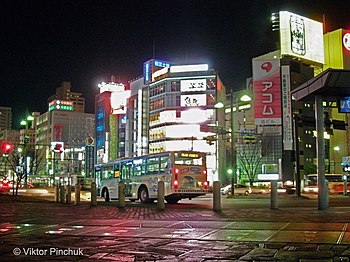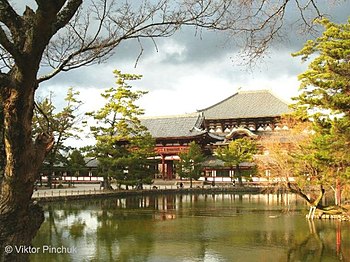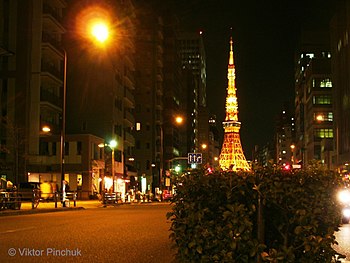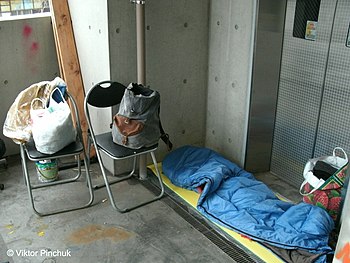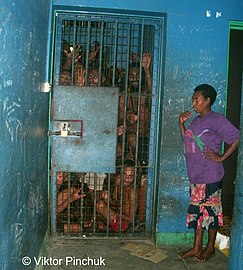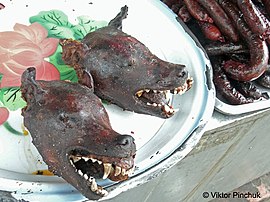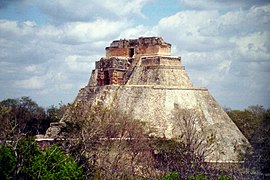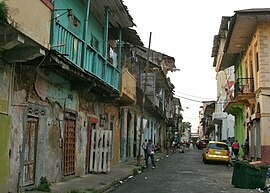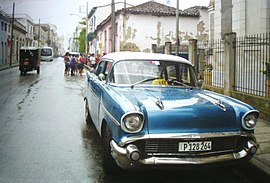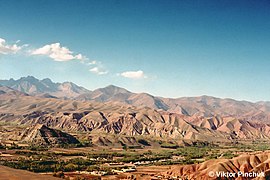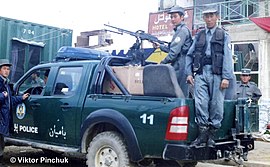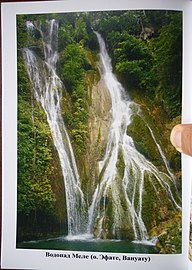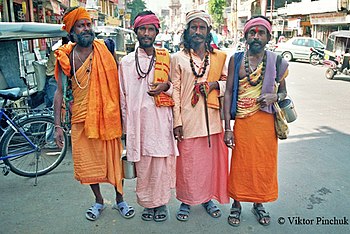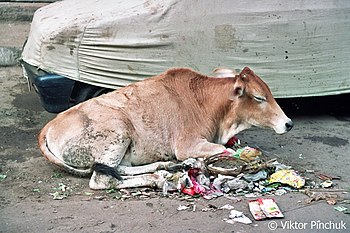Hobo tourism/Printable version
| This is the print version of Hobo tourism You won't see this message or any elements not part of the book's content when you print or preview this page. |
The current, editable version of this book is available in Wikibooks, the open-content textbooks collection, at
https://en.wikibooks.org/wiki/Hobo_tourism
Long intercontinental trips and expeditions

(This is what a person practicing bum tourism looks like)
Hobo tourism (or bum tourism) is a format of traveling around the planet in which the subject, overcoming the planned route, leads a more than Spartan lifestyle, where material costs are minimized. There are some similarities with backpacking, but in this case everything is much more complicated and extreme. This method originated in Russia in the post-Perestroika period; in Russian it is called «бомж-туризм» (pronounced: bomzh-turizm), where the first constituent word mean a homeless person.
Etymology
[edit | edit source]The term has at first glance a strange name for the reason that the existence of a traveler for a certain period of time becomes similar to the life of homeless people, who in Russia, since the 90s of the last century, have been called «бомж».
What is it for?
[edit | edit source]Makes sense to be used by people who don’t have enough funds, but creatively thinking, who make a feasible contribution to science, art and literature, or at least who want to improve their own knowledge. The essence of the method is that by saving money on personal comfort, you can visit many more places on the planet and, as a result, through historical and geographical (as well as in the field of other sciences) research multiplied by your own vision of the world, benefit your country and not only. The above method of transportation opens up additional opportunities for creativity — painting, photography, the creation of literary works in the genre of travel essays, etc. — which, upon returning to their homeland, allows the traveler in one form or another to acquaint compatriots inclined to a home lifestyle with what saw in a foreign land.
Going on a trip of the "bum tour" format, it should be remembered that you can not take expensive items with you: when sleeping on the streets, in the companies of bum natives and other similar places, spectacular equipment (smartphones, cameras, video cameras) can attract the attention of criminal elements. You need to look inconspicuous, clothes should not only be inexpensive, but also not stand out against the general background, i.e. without bright tones and motley shades. The material reserve should be divided into two or three parts and hidden on yourself, preferably in the upper part of the body, since during the route it is possible to ford shallow reservoirs (for example, streams), as well as moving by small-sized water transport with boarding and disembarkation in places where no specially equipped berths. It is advisable to use the method of ultralight backpacking: a small backpack without zippers, sleeping pad and a blanket (or sleeping bag) is the main attributes of bum tour. The presence of a tent is possible, but undesirable.
The form of clothing and the period of action
[edit | edit source]Following the example of migratory birds, you need to choose the end of autumn or the beginning of winter to set off, planning to return closer to summer. Since most international flights originate from capitals, the starting point is likely to be one of major cities. The above season is usually accompanied by low air temperatures, so you should put on outerwear, which is not a pity to throw away at the arrival airport, leaving only a light sweater, a scarf and sports hat made of thin warm fabric, that fits in a clenched fist: it can be cold at night even in tropical countries.
Tips for choosing a route
[edit | edit source]The route should include places with favorable climatic conditions. The ideal option is developing countries, where prices are low, and the expanses are not fully explored. The first world states, due to the high prices of goods and services, are suitable only for short-term transit on the way to the goal. The cold spots of the planet are not useful for practicing this method.
In order to save money, need placing in the ruins of abandoned houses, in the open air, in cemeteries, stairwells and halls of residential multi-storey buildings, as well as in other places where the presence of foreigners does not contradict native laws. If possible — in the homes of local residents: it is easier to get a bed for the night with poor people, residents of villages or small towns.
Methods of transportation
[edit | edit source]The main and irreplaceable way of traveling for a hobo tourist (as well as a backpacker) is hitchhiking. In addition, you can use budget transport (sometimes it has a specific benefit: at relatively low costs, time is saved). And a distance of up to 20 kilometers is easy to overcome on foot, which gives additional opportunities for learning about the world around you. A good option is to visit ten or more countries in one trip, in particular, if the route runs, for example, through Latin America, or the islands of Oceania. You can also take advantage of low-cost airlines and seasonal ticket sales.
Food
[edit | edit source]In poor countries (namely, they are of primary interest to those who have chosen this method), there are always points of street catering, where it is easy to purchase inexpensive dishes for a nominal fee. When staying overnight in the jungle — you can eat the gifts of nature, visiting the aborigines — what the owners will serve.
It's important to know
[edit | edit source]In recent years, the concept of "bum tour" and "bum tourism" sometimes apply by users of the World Wide Web in the meaning of "Slum tourism". There is a slight similarity between these terms; in particular, regarding the option of a traveler's residence in the communities of homeless people. Nevertheless, the clients of slum tourism, for the most part, are well — off people who want to find thrills in this new entertainment for themselves in order to dilute the routine of a monotonous, far from poor life. While the subjects of hobo tourism, who go on long journeys around the world "with a bag on their shoulders" — on the contrary.
Materials in Wikisource project
[edit | edit source]- Viktor Pinchuk "Notes of an international tramp"
- Viktor Pinchuk "In bullpen – voluntarily"
Overnight stays in long intercontinental journeys
Rest at night is one of the important moments in the practice of bum tourism: sleep is necessary for health and physical activity during long expeditions with low self—financing, where high energy consumption awaits you daily. Since sometimes, even in poor countries, the cost of hotel accommodation can be relatively high (for example, in Comoros — from 20 €, in Botswana — from $ 40), it makes sense to use the alternatives described below.
There are special hospitality networks for Internet dating with subsequent residence at home with the users of the resource in the country chosen for visiting — this practice is widely used by backpackers. With hobo tourism, circumstances can throw a traveler to places where there is no international web or (due to the unpredictability of obtaining visas along the way) to a country whose visit was not planned by the route. Spontaneous acquaintances with local residents come to the rescue, who sometimes don't mind inviting a foreigner to stay in their huts.
Unlike the previous method, where you need to adjust to the routine of the owners, and this is not always convenient (for example, sitting up late talking with the household suffering from boredom somewhere in a God-forsaken village on a small island, the name of which not all geographers know), the option is useful because you can go to bed in silence, choosing an acceptable time. A building abandoned by residents can be a one-story, or a high-rise skyscraper. In the latter case, there will be enough space for a large expedition group.
Construction projects that were mothballed are the best option for accommodating hobo tourists: there are no guards and builders working at night. At existing construction sites, overnight accommodation is possible with the permission of the responsible person. However, this is not feasible everywhere: in the big cities of Japan, Korea, China and Hong Kong, the objects under construction are surrounded by a multi-meter fence, which, to put it mildly, is difficult to penetrate.
The method may not be used in every country. Tested on his own experience by the Russian traveler Viktor Pinchuk in Japan and Taiwan[1][2]. Due to the similar mentality of the residents and the low crime rate, it can be assumed that a similar result is expected in South Korea. The rest of the countries have not been tested in this regard, so you can use this recommendation while staying there only at your own risk.
The method is common among backpackers and local hikers. But unlike the above categories, a hobo tourist, spending the night in nature, does not use a tent and a sleeping bag. In the jungle, on islands off the ocean coast and other places where the sky replaces the roof, it is possible to use this method only in the dry season; in settlements and adjacent areas — in the rainy season too: you should find a canopy that will protect at night in case of heavy rain.
This method is used in critical cases when there is no alternative. For example, if you arrival coincided with the late time of day, when there is no time to find the best option.
The use of this method can be useful in Japan and Hong Kong, i.e. where the prices for accommodation are quite high. Stairwells of technical floors of residential buildings and lobbies of institutions will save you from cold and atmospheric precipitation. There is no single universal way: in each specific case, you need to act with an eye to the circumstances and using intuition.
The method is widely used among local residents of five countries of the southern part of the African continent: South Africa, Namibia, Botswana, Lesotho, Swaziland (Eswatini). The police will also accept a white hobo tourist — on general grounds. In other countries, the use of this method is possible by agreement with police officers: based on their mood on the day of your arrival, and other nuances.
Almost every third world country has a separate category of hotels, which travel agency clients who visit the same country as part of a group of their own kind have no idea about. The main guests of such places are aborigines, who come from the province to a big city or the capital of their country for shopping or for another purpose. Sometimes bedbugs really live in such places.
The hostel is the main and most popular accommodation facility for backpackers; it is also used among travelers practicing bum tourism.
A method used in extreme cases (for example, if, due to the low temperature of the surrounding air, sleeping in the open air can cause harm to health).
The method can be called "exotic", due to the fact that not all countries have pyramids.
In the terminals of international airports
[edit | edit source]No more than one night is used: on the day of arrival in the country, or the day of departure. It is convenient if the plane arrived late in the evening, or an early morning departure is expected.
Other possible options
[edit | edit source]- In temples and mosques of Arab countries.
- Under benches in Chinese trains, or in the vestibule of Indian trains (during crossings).
- In the hospital. Tested in South Africa.
- On the bus leaving the next morning. It is practiced in African countries, if you have a ticket. It is convenient that you do not need to look for a bus station in the early morning — you can inspect dreams during passenger boarding.
- In the waiting rooms of railway stations. It is possible in many countries, except Japan, where terminals are closed from 00 to 06 hours and trains do not run.
- In a separate booth of an Internet cafe. Invented and used in Japan by local residents who do not have enough funds for hotel accommodation. You will need to pay, but compared to hotel rates, it's nothing.
- In the ATM pavilion. If there is a bank card that allows you to get inside.
Quote
[edit | edit source]
- Will share the secrets of my street sleepovers. If you get into an unfamiliar city, can stay anywhere, even on the central avenue under the walls of buildings, but on one condition: you need to deploy after midnight, and leave before six in the morning. At six, the first passerby may appear, probably suffering from insomnia, in half an hour there will be several of them, and closer to seven — a lot. [3]
Materials in Wikisource project
[edit | edit source]- Viktor Pinchuk "In bullpen – voluntarily"
References
[edit | edit source]- ↑ Pinchuk, Viktor. Two months of wandering and 14 days behind bars (in Russian). Russia: Brovko. p. 18. ISBN 978-5-9909912-5-5.
- ↑ Pinchuk, Viktor. Japan for free (in Russian). Russia: Brovko. p. 27-28. ISBN 978-5-9908234-1-9.
- ↑ Pinchuk, Viktor. Six months by islands... and countries (in Russian). Russia: Brovko. p. 32. ISBN 978-5-9908234-0-2.
Overnight stays in long intercontinental journeys/In the flophouse (dosshouse)

Flophouse & dosshous (also: outsider hotels, hotels without stars) are facilities designed to accommodate guests moving within their own country (in this context, in relation to "developing countries"). In most cases, they can be used by foreigners.
Coaching inn
[edit | edit source]A fenced area in the open air, where several dozen metal beds are located — this type of accommodation is found in Sudan. When staying overnight in such a "hotel", in order to avoid unwanted loss of property and equipment, the backpack should be deposited in a special room, the key to which is with the responsible person ("caretaker").
Mehmunsaray & mehmunkhane
[edit | edit source]The Afghan version. When choosing this accommodation facility for temporary residence, you should know that they sleep on the floor here (Afghans also sleep on the floor in houses — this is a local tradition), and therefore, the number of beds in the room is conditional. There is no furniture, and instead of a hanger, usually a nail is driven into the wall. Toshnab (toilet in Farsi) can be located on the street, three hundred meters away (as it was, for example, in the mehmunsarai of Bamyan — see video #3 in the gallery)
To settle in one of the most budget place in Kabul, you need go to the Kote Sangi district on the outskirts of the city. The cost of a berth in the accommodation facilities here ranges from $4-6, and mehmunsaray at the lowest price, is divided into squares (cubes) along the corridor by glass partitions, outwardly similar to an aquarium, where each division has a size of 1.5 x 2 m [1].
However, in this hospitable country, you can do without "hotels": the local poor, who sometimes live without locks on the doors, will be glad to have a foreign guest. (See chapter of the textbook "In Aboriginal dwellings").
Guest House
[edit | edit source]A common variant in African countries. It is used by local residents when moving from one locality to another: since there is no direct transport connecting distant points of a particular country, you have to go with transfers, stopping for the night in such places in order to continue the moving in the morning. Guest house is a simple room where the shower and toilet are outside. Sometimes the "shower room" is inside, separated from the bed by a partition, behind which you can douse yourself with water from a plastic canister. A guest arriving from abroad will be accommodated on a general basis, at the same price or, what happens more often, slightly overstating the price list. Guest houses are also found in Asian countries. When choosing this method of accommodation for settlement in an African or Asian country, it is necessary to imagine in advance that guest houses in the third world space are fundamentally different from European counterparts.
Exceptions to the rules
[edit | edit source]Cases when a foreigner may not be accommodated in a similar accommodation object described above are extremely rare. In Cairo, on Clot Bey Street, located near the railway station (Ramses district), some owners of squalid real estate do not have a license to accommodate citizens of other countries. To implement the plan, it is recommended to walk to the end of the street, examining all the buildings, given that some of them may have signs in Arabic, not duplicated English. You need to be prepared for the fact that bedbugs can live in the room where you will still be settled: this is not often, but it happens.
Additional information
[edit | edit source]Hostel
[edit | edit source]This object assumes living in the same room of several people who are strangers to each other. Hostels, usual, are located either in capitals and large cities, or in places of increased interest for foreigners. As an example of the second option — the tiny town Aguas Calientes, where people come from all over the world who want to see the lost Inca city — Machu Picchu. Hostels are widely used by backpackers, but hobo tourists sometimes stay in these accommodation facilities. Here, as a rule, clean; the bed linen is washed, the rooms are cleaned. And the low price is achieved by the fact that up to 12 people can be accommodated in one room, which is called a dormitory.
The choice of such objects is recommended for lovers of communication and noisy (mainly youth) companies.
For the same price — with comfort
[edit | edit source]In some countries (in particular, Laos, Cambodia and Vietnam), you can stay in a relatively good hotel for a symbolic amount of 5-7 USD, which allows a hobo tourist to forget about his lifestyle for a while. In this case, it is not rational to look for alternative placement methods.
Gallery (photos and videos)
[edit | edit source]-
Single room in Kermanshah (Iran, 2008)
-
Dormitorium in hostel. Surat
(India, 2006) -
A room in Mehmunkhane, Bamyan.
(Afghanistan, 2008) -
Hotel Murah (in transl. with Indonesian — "Cheap hotel"), Makassar (Indonesia, 2013)
-
Quadruple room in Damascus
(Syria, 2008)
References
[edit | edit source]- ↑ Pinchuk, Viktor. Afghan prisoner (in Russian). Russia: Brovko. p. 55. ISBN 978-5-9909912-3-1.
Overnight stays in long intercontinental journeys/In Aboriginal dwellings
Staying at the an aborigines dwellings is a method used not only by hobo tourists, but also by backpackers, and sometimes by ordinary people (more often from among young people) who want to visit a particular country without large expenses. To achieve this goal, Hospitality exchange service are usually used, the participants of which offer foreigners accommodation for some time on their own living space.
But, if backpackers and "beginners" prefer to choose highly developed countries and large cities to visit, a traveler practicing hobo tourism can get to places around the globe where there is no Internet, and about the aforementioned service bobody knows. In this case, spontaneous acquaintances with local residents will help. Sometimes aborigines invite a wanderer to visit on their own initiative, but since this does not always happen, you can arrange an overnight stay with local residents yourself.
A guide to action
[edit | edit source]To get things done, you need to know a few basic truths:
- Rural residents are more likely to receive guests than city dwellers. Sometimes the villagers' dwellings do not have locks: there is nothing to steal. The probability that the owner of a comfortable apartment located in a major city of any country will invite one or more foreigners to his home is much lower, and in megacities it is close to zero.
- The inhabitants of God-forsaken corners of the globe (in particular villages located on small islands) are bored by the lack of events. A foreigner from a distant country is the only way for them to communicate, an option to speak out.
- In a rural area or a small town, you can, after waiting for the evening, independently knock on any dwelling, asking for a place under a canopy in the yard; with a negative result, repeating the action repeatedly.
Fact
[edit | edit source]Russian traveler Viktor Pinchuk, moving through the territory of Papua New Guinea (in 2013) for more than twenty days, never resorted to the services of hotels, during the entire period staying with the aborigines[1].
Gallery
[edit | edit source]Illustrations from books:
Pinchuk, Viktor "Six months by islands... and countries". — Simferopol: Brovko, 2016. — 216 p. — ISBN 978-5-9908234-0-2 (photo #1-3)
Pinchuk, Viktor "Two hundred days in Latin America". — Simferopol: Brovko, 2017. — 210 p. — ISBN 978-5-9909912-0-0 (photo #4)
Pinchuk, Viktor "Two months of wandering and 14 days behind bars". — Simferopol: Brovko, 2020. —116 p. — ISBN 978-5-9909912-5-5 (photo #5)
-
On a visit to the Malaysians
(Sukau, Sabah, 2013) -
On a visit at Indonesians
(Sumatra Island, Indonesia, 2013) -
On a visit to the Papuans
(Western Highlands, PNG, 2013) -
On a visit to the Cubans
(Guisa, Cuba, 2015) -
On a visit to aborigines of the Pentecost Island (Ranwas, Vanuatu, 2020)
References
[edit | edit source]- ↑ Pinchuk, Viktor. Six months by islands... and countries (in Russian). Russia: Brovko. p. 116 - 140. ISBN 978-5-9908234-0-2.
Overnight stays in long intercontinental journeys/In an abandoned building

(Photo from book "Six months by islands... and countries", p. 30)
Sleeping in an abandoned building is one of the many ways for a traveler to get a night's rest using the hobo tourism methods.
Place for accommodation — empty buildings intended for demolition, with dismantled window and door blocks — if desired, you can find in any country of the world.
Pros and cons
[edit | edit source]Sometimes such objects (due to the fact that the residents have been evicted for a long time and the structure is not protected from the destructive effects of precipitation) are in an emergency condition, there may be a pungent smell of dampness inside. At the same time, despite the above disadvantages, this method has its positive sides. For example, unlike overnight accommodation at an existing construction site, where the working day begins in the morning, there is no need to get up with the first crowing of the roosters. It is easy to find a hiding place in the ruins where you can hide backpack (keeping your valuables with you), allowing you to wander around lightly during the day.
Equipment
[edit | edit source]When using the method, the same standard set of equipment is used as for overnight stays in the open air and in cemeteries:
- Roll mat & polyethylene oilcloth twice the size (so that the lower plane of the mat does not get dirty),
- inflatable pillow,
- Bedspread or blanket.
A practical example
[edit | edit source]- Events of 2019, Port Vila, Vanuatu (see "Gallery, photo 1")
"On the main street — empty government building with a sign at the entrance. It's not hard to get in, there are no guards, but there are a lot of people around: can't do it without being noticed. A second option — an abandoned house on the outskirts of town — proved unfit for the night: there were puddles in the rooms (a consequence of heavy rain and a roof that had been blown off). "Bad luck, will have return to Pango," — thought, when a heavy downpour came. Ran towards the bus stop. The door of building was ajar in one of the alleys, darkness behind it. I went in, took out a torch. A room with a high ceiling looked like an assembly hall. Meanwhile, the rain outside had intensified, drumming furiously on the slate roof. Chose place to sleep in the far corner, where an extra, back door was covered by roller shutters. The room had not been used for a long time, so there was almost no chance of anyone coming in. To avoid attracting attention, left the front door unlocked, and hung my wet clothes on the nails I had hammered in [1].
Gallery
[edit | edit source]Illustrations from the books::
Pinchuk Viktor "Two months of wandering and 14 days behind bars". — Simferopol: Brovko, 2020. —116 p. — ISBN 978-5-9909912-5-5 (photo #2)
Pinchuk Viktor "Six months by islands... and countries. — Simferopol: Brovko, 2016. — 216 p. — ISBN 978-5-9908234-0-2 (photo #3,5)
-
Port Vila, Vanuatu, 2019
A derelict building in the city centre -
On the island of Eua, Tonga, 2019
Abandoned forester's lodge -
Kuala Lumpur, Malaysia, 2012 (I)
View from the apartment window -
Kuala Lumpur, Malaysia, 2012 (II)
Bed space -
Kuala Lumpur, Malaysia, 2012 (III)
View outside
References
[edit | edit source]- ↑ Pinchuk, Viktor. Two months of wandering and 14 days behind bars (in Russian). Russia: Brovko. p. 63-64. ISBN 978-5-9909912-5-5.
Overnight stays in long intercontinental journeys/In the company of homeless people
Staying overnight in homeless companies and communes is a method of obtaining a night's rest (and sometimes a short-term stay) practised by supporters of hobo tourism.
Why is it needed?
[edit | edit source]There may be several reasons for this seemingly strange accommodation option:
- Arrival in next city of exotic country coincided with the late time of day, when there is no option.
- A traveller sleeping in the company of homeless people may not be noticed by street criminals, whose activities become more active at night; but a foreigner sleeping alone on the street will be the object of unnecessary attention by criminals.
- People living on the streets and train stations can help a beginner in understanding of local traditions, for example, how to protect themselves from petty thieves who can covet seemingly worthless items, etc.
- Living in a commune of the homeless provides the traveler with opportunities to experience the life of the lower classes of the society.
- Sometimes the homeless community has a habitable structure (a ruin or unfinished building) where a proponent of the hobo tourism methodology can live for some time (read more below, in the "Practical Examples" section).
Comparing the method to "Slum tourism"
[edit | edit source]The Russian traveler Viktor Pinchuk, who uses unconventional methods of travelling, has repeatedly lived and stayed overnight in underclass and sometimes socially deprived places. As a rule, a foreign tourist who has lived side by side with beggars for some time, who is not opposed to them and has no privileges that elevate him above others, is respected by slum-dwellers without provoking negative emotions, and his visit does not leave an unpleasant residue in people's memory, which may appear after visiting narcissistic sightseers with expensive photo and video equipment.
Practical examples
[edit | edit source]This is how the books describes a traveller's encounter with the homeless in Indonesian capital:
Behind the decrepit fence — abandoned unfinished building: just the thing. Apparently, someone lives there. I called out. A young Indonesian with a confused expression came to the fence. Asked him by signs if I could come in. He pointed to the gate on the other side. It was opened. An elderly woman came out. "Can I sleep here?" — uttered a phrase in the local language, prudently learnt by heart. The old woman, smiling, permitted. The four-storey derelict building had no walls. Part of the ground floor was occupied by a commune of homeless people, the upper floors were empty. The guy took me to the second floor, where a spring mattress from a double bed lay on the concrete floor. Next to it was a wooden bench, like the ones they use in hospitals and on beaches, with a pile of rags on it. "You can cover yourself with this," the Indonesian explained and walked away. Of the "furniture" in the space allotted to me there — only the two items described, and there is a "toilet" that don't know its purpose yet. I approached the "balcony" (there were ones on four sides): a pile of rubbish below, in the distance the neon-lit buildings of expensive hotels [1].
Late in Surabaya, Indonesia:
...Leaving the bus, I walked a hundred metres, looking for a nook to sleep. The midnight street was lit by lanterns. On the left, under a long awning on the pavement, lay a community of homeless people who reminded me of their counterparts in the Indian city of Mumbai. I walked a little further — nothing suitable. However... Turned around and turned back. Perhaps the African natives would envy these people: they have electricity that is not always present in the Black Continent. I approached the two men sitting under the light bulb. The old man, hearing a question in his native language, shook head negatively and with a disgruntled expression on his face, asked to go back to where had come from. This was an odd reaction. Usually beggars in third-world countries are enthusiastic about such a request. In fact, who says this grandfather is the "boss" of the homeless? I'll ask others. At the very end of the "settlement" there were two more: a middle-aged man was sleeping on the ground, while a young man of indeterminate gender, with an earring in his ear, was watching... television. The mains cable from a small television receiver went somewhere upwards, probably to an electric pole. On closer inspection, the street television viewer turned out to be a man. "Everything here is occupied," — he explained with a smile, — and the empty lot in the corner is for the motorbike. "You can set up there," — the guy added, pointing to the threshold under the closed double door of the building a metre away from the motorway. Far from luxury, even by the standards of a bum, but at midnight there was no alternative. With an affirmative nod of my head, I spread out a mat and soon fell asleep to the lullaby of the occasional passing car [2].
And this is about an overnight stay in Guangzhou, China:
...On the lower span of the bridge, occupying a well-lit area behind the railings, the three were resting peacefully after a noisy day at the railway station. The older one, apparently mute, mooed only occasionally, the second, a middle-aged bum, was sullen and taciturn, and the youngest was slightly different from his brethren: he had not yet reach the standard. He was the one I asked about spending the night in their company. "No problem!" — he replied with a sign and, watching me spreading a mat, decided to instruct the guest. Passers-by squinted at this scene and, without stopping, walked on, spurred on by the overcast weather. Noticing that I looked at the clouds, the guy shook his head, "No, it's not going to rain." — "Shoes, just to be safe, you'd better put them under a pillow," — he explained, — "they'll get dragged away. "But my shoes is very old" — I replied, being quite surprised. "That's not the point," the instructor went on, "a beggar boy tramp (there are many of them here) might come up and ask for money, and if you don't give it, he'll grab the shoes and run away. — "And the backpack has to be wrapped around both arms and covered with a blanket," the homeless man explained, seeing me tie the strap to my arm. "Tying it won't save you, they might cut it off..." — he added. At this time the oldest of the two made a sound and my interlocutor approached him.[3].
Gallery
[edit | edit source]-
The second (vacant) floor of an unfinished building housing a community of homeless people. Jakarta, Indonesia. (Photo from book by Pinchuk Viktor "Six months by islands... and countries")
-
"Shower room" in an Indonesian commune of homeless people (Jakarta, Indonesia), which Russian traveller Viktor Pinchuk used with them.
-
One of the inhabitants of the railway station in whose company the Russian traveller spent the night; Guangzhou, China (Photo from book by Pinchuk Viktor "Six months by islands... and countries")
References
[edit | edit source]- ↑ Pinchuk, Viktor. Six months by islands... and countries (in Russian). Russia: Brovko. p. 64 - 65. ISBN 978-5-9908234-0-2.
- ↑ Pinchuk, Viktor. Six months by islands... and countries (in Russian). Russia: Brovko. p. 77 - 78. ISBN 978-5-9908234-0-2.
- ↑ Pinchuk, Viktor. Six months by islands... and countries (in Russian). Russia: Brovko. p. 157. ISBN 978-5-9908234-0-2.
Materials in Wikisource project
[edit | edit source]- Viktor Pinchuk "Notes of an international tramp"
Overnight stays in long intercontinental journeys/In a public toilet
Kasuga-taisha, Nara (Japan)
Staying overnight in a public toilet — a variant of night rest travelers using the methods of bum tourism.
Used in emergencies; for example, if air temperature or precipitation do not allow sleeping outdoors.
Equipment
[edit | edit source]Standard kit of hobo tourist: plastic sheeting (to protect the underside of the sleeping pad from dust), an inflatable pillow, plaid or sleeping bag.
Cases from practice
[edit | edit source]Russian traveller Viktor Pinchuk twice used this method in the fourth solo expedition to Africa: when crossing the border between Lesotho and South Africa; and in the city of Oudtshoorn, where he went to the police station, and was identified by an officer for the night in such an extravagant place[1][2].
Here is how one of the aforementioned cases is described in the book "Holiday of wandering mzungu":
"Another hour of walking, I noticed in the distance several separate sources of light: lanterns, or windows of houses. Even if it is a village — also not bad. When the building of a border checkpoint was visible ahead, the road was blocked by a stream flowing from the mountain. I took out a flashlight. Having crossed the ford, has stumbled into... closed gates. Surprise! What to do? There are three options: climb over the fence; stay on this side until the morning ("sleep" jumping on one leg, or lying — shivering from cold); long time shouting wild cry. I chose the third point as the most sensible. Continuing to yell frantically, noticed a police car approaching the building with glowing windows. I took out a flashlight, adding a sound signal with a light. Soon the car left, and with it the hope. Without paying attention to the details, continued what I had started. A man came out of the luminous building. Approaching the gate, he asked where I had come from. "From Lesotho", said, holding out my passport through the bars. The border guard has opened the lock. We approached the office walls, he fled the door and, putting a stamp with the inscription Sani Pass, returned the document through the window: "You can go". It began to rain. "And how many kilometers to the city?" — "About thirty". — "Can I sleep here?" — "This is the border, impossible". Having inspected the territory of the border guard, I found a toilet: quite clean, cozy and without an unpleasant smell. "Can I stay overnight in the WC?" — asked, returning. "Well. Only passport surrender till morning" [2].
In the Japanese city of Nara near the temple complex Kasuga-taisha, located in a forest park on the outskirts of the city, a suitable option (see video). However, overnight in the WC did not take place because an alternative was found — the vestibule of high-rise [3].
Aspects of application
[edit | edit source]This option is presented for theoretical study, the use of the method in practice is low probability.
References
[edit | edit source]- ↑ Pinchuk, Viktor. Holiday of wandering mzungu (in Russian). Russia: Brovko. p. 138. ISBN 978-5-9908234-0-2.
- ↑ a b Pinchuk, Viktor. Holiday of wandering mzungu (in Russian). Russia: Brovko. p. 152-153. ISBN 978-5-9908234-0-2.
- ↑ Pinchuk, Viktor. Japan for free (in Russian). Russia: Brovko. p. 22-23. ISBN 978-5-9908234-1-9.
Overnight stays in long intercontinental journeys/At the police station

Photo from the book "Six months by islands... and countries"

Photo from the book "Six months by islands... and countries"

Overnight stay at the police station has nothing to do with forced confinement of law and order offenders; it is an official rule applied by five countries in the southern part of the African continent: South Africa, Lesotho, Eswatini (Swaziland), Botswana, Namibia — for residents. Following local traditions, traveller practising methods of bum tours can find overnight accommodation in a police station — on general grounds.
In theory
[edit | edit source]This method is used by locals who come from the provinces to the big city and cannot afford even the cheapest room in a simple hotel. The officers allow "lodgers" to stay at the police station if they plan to leave the city in the early hours of the morning. Double or even multiple overnight stays at the same police station are not allowed. The measure is intended to protect the African population from street crime, which is more active at night.
In practice
[edit | edit source]If a white traveller arrives to spend the night, the police in the above-mentioned countries will "house" him or her in the same way as local "clients", i.e. without singling out from the general public. In villages and provincial settlements (where there are hardly anybody willing to spend the night at the police station) the foreigner will be received more kindly: the officers will allow him to spend the night in a horizontal position and may provide with a separate room (for example, some sort of meeting room). In big cities and capitals it is different: a traveler who came to spend the night won't be turned away but he will have to "sleep" in a sitting position on a bench at the hall, next to dark-skinned "companions in misfortune".
This is not an official practice in other parts of the world but the police can be of help to the stranger — it depends on the personal character of both the traveler and the law enforcement officers.
For a description, with concrete examples from the traveller's own experience, see Wikisource at the link in the relevant section below.
- Most foreigners visiting countries in southern Africa — people who are wealthy, they arrival to visit national parks and unaware of this method.
- South Africa has a special service for victims of street crime and domestic violence, where a Russian traveller who sought help at the Leroro police station once spent the night (12 April 2018):
Five minutes later, when I was ready to lie down on the floor and come to sleep, a police officer entered the room and mysteriously informed me that there was a much more comfortable option. Having gathered my things, I followed the uniformed man. As if at customs before a flight, my luggage thoroughly inspected and I was escorted to the next building — a rehabilitation centre for victims of criminal offences. "If you don't have money to live in a hotel, then in a way you are a victim too," the policeman said. I was allocated a separate room with two beds and I selected the one I liked. A black woman, a staff member of the "Remmogo Victim Support Centre", escorted me to the shower room, handed a toothbrush with toothpaste and soap, took my clothes to the wash, and provided me with second-hand clothes in return. I tried — the size fit. After the ablution, I got dinner — a national dish, similar to porridge. "No victims today but you," said the "housewife". — "Are there any at all?" — "Of course," replied the woman: "people who have been robbed by criminals, wives of violent alcoholic husbands... [1]
Materials in Wikisource project
[edit | edit source]- Viktor Pinchuk "In bullpen – voluntarily"
References
[edit | edit source]- ↑ Pinchuk, Viktor. Holiday of wandering mzungu (in Russian). Russia: Brovko. p. 169. ISBN 978-5-9908234-0-2.
Overnight stays in long intercontinental journeys/In halls and stairwells

Staying overnight in the lobby of an office structure or on the landing of an apartment building is a variation of a hobo tourist's night rest.
The option was tried out by the Russian traveller Viktor Pinchuk in Japan and Hong Kong.
In the big cities of Japan, some high-rise office and residential buildings do not have code locks at the front entrances, particularly the old nine-storey apartment buildings. If you go up the stairs, there is a technical floor at the top, a not big area of which is quite suitable for a night's rest.
Sometimes it is not necessary to go up. This is what it looks like in practice:
"Osaka is the second largest and third most populous city in Japan. I was not invited to visit, spent the night in the entrance hall of a relatively (by Japanese standards) small building. We live in the 21st century, high-rise blocks have a security at the entrance. Japan is not far behind. Only the guard was not at workplace: for a long time and to no avail I knocked on his booth through the tinted glass. A cosy, dead-end corridor, lined on the left and right with letterboxes, is where the stunned Japanese found the early morning "alien".[1]
The same traveller, while in Kyoto, lived on the floor of a student dormitory for several days, having a rest at the door of the lift which does not work at night (see video), and leaving his backpack dayly in the lobby during the day. While in Hong Kong, he spent the night on the top floor of a high-rise building, near the roof exit door, where permanently hid backpack started from the second day of stay [2].
A guide to action
[edit | edit source]On the basis of the above, the recommendations for using this method can be summarised as follows:
- Find a high-rise building that does not have a combination lock, climb to the end of the stairs and (if there is a technical floor and space is available) spread out a sleeping pad on the concrete and lay down to sleep.
- Go into the lobby of the building; if a guard is present, ask him to allocate two square metres on the floor for sleeping. If there is no guard present, choose a secluded corner on your own and go to bed quickly, making as little noise as possible.
References
[edit | edit source]- ↑ Pinchuk, Viktor. Japan for free (in Russian). Russia: Brovko. p. 7. ISBN 978-5-9908234-1-9.
- ↑ Pinchuk, Viktor. Six months by islands... and countries (in Russian). Russia: Brovko. p. 144. ISBN 978-5-9908234-0-2.
Overnight stays in long intercontinental journeys/At the cemetery

Photo from the book: Viktor Pinchuk "Japan for free"

An overnight stay in cemetery is one option getting sleep for the travellers practising hobo tourism methods.
Cemeteries in some countries are ideal for this purpose.
See below for a list of places around the world where this method can be used, as well as the pros and cons.
Where and how?
[edit | edit source]The method is not applicable in every country. It was tested by the Russian traveller Viktor Pinchuk in Japan and Taiwan [1][2]. The positive factor in this case is that the inhabitants of the above countries (as if showing care for travellers, who use methods of hobo tourism) do not place portraits of the deceased, who could materialise in dream and appear to a sleeper. In addition, the tombstones dont have frightening dates of life (or they are written in hieroglyphics).
Given the similar mentality of the population and the low crime rate, it can be assumed that a similar result is to be expected in South Korea and Hong Kong.
Members of Russian traveller Anton Krotov's expedition, on their way to Sudan through Egypt in 1999, noticed the inhabitants City of the Dead occupying crypts on the outskirts of Cairo: almost every one was inhabited by a poor family; some of the cemetery buildings were empty, which the travellers took note of [3].
In analysing the above, conclude that this method is also applicable in the Arab territories In countries with high levels of street crime, however, sleeping in cemeteries is strongly discouraged. These include: Brazil, Papua New Guinea, Venezuela, South Africa (cities such as Johannesburg and Pretoria).
The equipment
[edit | edit source]A standard hobo tourists kit: a ground pad, an inflatable pillow, a blanket or a sleeping bag (the latter is essential when visiting colder areas). It is not advisable to pitch a tent (particularly in bright colours): it may attract unnecessary attention, and there is no telling how the locals will react to such actions.
Why?
[edit | edit source]Used on a one-off basis in countries with high hotel costs and low crime rates, usually during a transit stay in an area of a settlement. It is not advisable to sleep in a cemetery for a lot of times: if you stay somewhere for a few days, it is possible to find more suitable accommodation in the meantime.
Why not go to sleep on a park bench if there is no crime in the country? Indeed, such an alternative is possible. However, a cemetery is a quiet place, with no visitors at night; a person sleeping on a bench can be the object of attention from the police (who, upon noticing a foreigner, might think that his or her visa is not in order), the guard of the area used for sleeping, or curious passers-by. Of course, in the end, the police will sort out and the curious passers-by will leave after asking you a few questions, but part of your night's rest will be spent awake.
For information
[edit | edit source]There are reports online that poor people in the Philippines, like the Egyptians, use cemeteries as permanent residences [4].
References
[edit | edit source]- ↑ Pinchuk, Viktor. Japan for free (in Russian). Russia: Brovko. p. 27-28. ISBN 978-5-9908234-1-9.
- ↑ Pinchuk, Viktor. Six months by islands... and countries (in Russian). Russia: Brovko. p. 18. ISBN 978-5-9908234-0-2.
- ↑ Krotov, Anton. It's you, Africa! (in Russian). Russia: Drofa (Moscow). ISBN 5-93281-008-4.
- ↑ Фомичева А. "В царстве мертвых: почему на Филиппинах люди живут на кладбищах". fishki.net (in Russian). Retrieved April 22, 2023.
Overnight stays in long intercontinental journeys/In the ancient pyramid

This article of the textbook is of a theoretical nature, due to the narrow possibilities of applying the method described below.
General information
[edit | edit source]Ancient pyramid-like structures are found in many countries of the world: Indonesian Borobudur ; numerous creations of Maya civilization, preserved in the territory of present Mexico, Guatemala and El Salvador; some of the Khmer temples of Cambodia, etc. The classic version, in the most used sense of the word, is in Egypt and Sudan.
The Egyptian pyramids are too large; the conventionally called burial chamber is located deep underground, which creates inconvenience for use as a place of the rest for hobo tourists, besides this, entrances to the majority of "last refuges" of pharaohs are сlosed and guarded.
This is not the case with the Sudanese pyramids: they are much smaller and have a kind of "front door" — small rectangular annex, a room-corridor leading to nowhere. The pyramids of Sudan are not tombs, but rather monuments to the deceased grandees of the ancient kingdom — some historians and researchers are inclined to this version.
Which pyramid to stay in?
[edit | edit source]Not all pyramids in the Sudan are suitable for rest and sleep: most of them are destroyed by time. If you drive from the border with Egypt towards Khartoum — on both sides of the road there are dozens of pyramid-like structures: on the left — fenced space, where an entrance ticket is required, on the right — objects are not guarded, the passage to them is open. Choosing one of the surviving "tombs", you can lay down in it and relax, following the example of the author this article (see photo). It is preferable to use an ancient building for daytime recreation, when the outside is very hot, but you can also settle down here for the night.
Meals and equipment
[edit | edit source]It should be remembered that the pyramids are in the desert, where it is impossible to find any food. Therefore, if you plan to stay here for more than one day, should stock up on products in advance.
The equipment used is a standard set of hobo tourists.
Gallery
[edit | edit source]-
Sudanese children watch sleeping in the pyramid
-
Pyramid with a "antechamber", suitable for recreation
-
Broken pyramids, unsuitable for rest and sleep
-
Same kids on pyramid ruins
Literature
[edit | edit source]- Pinchuk, Viktor (in ru) "Third African trip". — Simferopol: Phoenix Enterprise, 2013. — 56 p. — ISBN 978-617-671-039-4
Overnight stays in long intercontinental journeys/On objects under construction
Overnight on objects under construction — one of the options for relaxation in the dark time, used by travelers practising methods of hobo tourism.
Object selection recommendations
[edit | edit source]Choosing this method, it is preferable to settle down for the night, using the mothballed construction site (i.e., where no work is being done). This will allow you to act on your own, without adjusting to anyone. On the territory of the active construction sites you can be placed only with the permission of the responsible person. Sometimes such sites live workers.
Arguments
[edit | edit source]One of the advantages of the method is protection against soaking, which is possible when sleeping under the open sky in rainy season. Another advantage is that you will not be bothered by the midnight conversations of the owners of the house, which is likely in the case of overnight stays in Aboriginal dwellings; and nobody will not be lifted you at 5-6 am for wet cleaning — as with a night in the police.
Equipment
[edit | edit source]Polyethylene film, for laying under the ground pad (protecting the lower plane of it from dirt), actually the travel mat, inflatable pillow, blanket or sleeping bag.
Mosquito net are needed in countries of tropical climates.
Example from practice
[edit | edit source]In Sudan, there was a case where people living in an unfinished building (apparently homeless) asked a traveller for a small sum of money for the possibility of accommodation [1].
References
[edit | edit source]- ↑ Pinchuk, Viktor. Third African trip (in Russian). Ukraine: Phoenix Enterprise. p. 13. ISBN 978-617-671-039-4.
Overnight stays in long intercontinental journeys/Under the open sky


Staying overnight under the open sky is a well-known method used by travelers since time immemorial. The first to try it in practice were the medieval pilgrims. It is now used by local hikers, backpackers, and travelers, including supporters of hobo tourism.
Places of use
[edit | edit source]- On city streets, in park areas (in Japan, South Korea and other low-crime countries).
- In the jungle, or suburban thickets (in islands of Oceania, some countries in Asia, Africa and Latin America).
- On the coasts of oceans, seas (in tropical countries, on islands).
- In deserts (in this case implied relatively small deserts, as visiting large deserts requires special preparation).
- On the rooftops of inhabited (with the permission of their owners) and abandoned houses.
- Having joined the street homeless (in some cities there are communes — from three people or more).
- At the cemetery (in Japan, South Korea and Taiwan).
- On the Coaching inn (Sudan).
Equipment
[edit | edit source]- Sleeping mat and polyethylene film twice the size (it is placed under the mat).
- Blanket or sleeping bag.
- Mosquito net (need in the tropics)
- Inflatable pillow
- The use of a tent is undesirable: having fulfilled its purpose during a rainy night, in wet form, it will become a burden for the owner during hiking. Travel light; adjust to weather conditions, avoid sleeping outside in case of expected rainfall.
Examples from the practice of modern Russian travelers
[edit | edit source]Anton Krotov, returning from a long trip (1999) that included several countries, including the Sudan and Egypt, writes:
We spent the night on stones on the seashore. We spent the night in the gardens and in the fields. We slept in the desert. We slept on the rooftops of houses. We slept on the grass. We spent the night in villages and towns, visiting people when they invited us [1].
Viktor Pinchuk: in 2015 left without cash in Cuba (international bank cards are not valid in this country); more than two weeks lived on the street, including a huge thicker, meter-thick weeds wasteland in Havana near the Russian Embassy.[2]
References
[edit | edit source]- ↑ Krotov, Anton. It's you, Africa! (in Russian). Russia: Drofa (Moscow). ISBN 5-93281-008-4.
- ↑ Pinchuk, Viktor. Two hundred days in Latin America (in Russian). Russia: Brovko. p. 166. ISBN 978-5-9909912-0-0.
Overnight stays in long intercontinental journeys/Hostels

Hostel — an onject of accommodation, applies among others in the practice of hobo tourism. Widely used by western backpackers, popular among young people.
General information
[edit | edit source]The hostel is a tourist accommodation, where in one room, called «dormitory» (should not be confused tourist dormitory and dormitory for students and gastarbeiters), can be located from four to twelve and more inhabitants. Bunk beds are usually used to save space, and the shower and toilet are outside the room. In some hostels guests are given breakfast (which is included in the price of accommodation) in the common dining room; regardless of the location on the globe, «dishes» always look traditional: toast bread, butter and jam in disposable packages, tea or coffee. Sometimes hostels have a kitchen where you can prepare meals using your own products
Where are they located?
[edit | edit source]Hostels are usually located in large cities (including capitals), or places of interest by tourists. In small towns and villages, low-cost hotels targeting the local poor or a wide range of alternative methods may be an option.
Some features of hostels
[edit | edit source]- In some cases, the interior design and interior design of the hostels resembles a hippie commune, more often the interior is made in a classical style.
- In the hostels reigns a special atmosphere, some internal microclimate of the community of backpackers, travelers and tourists. From the outside, it looks like there’s a large family living here.
- Sometimes in hostels there are special "luggage storage", where everyone can leave their backpack — without any control from the staff, on trust. Or else things can be left anywhere — usually not stolen here.
Recommendation
[edit | edit source]Accommodation in hostels will have to taste of those who love communication, noisy companies.
Practical example
[edit | edit source]In Mexico City, for the same price, you can get a bed in the hostel or a separate room in the hotel (2015 information):
"Some will say that the amount is small, but for me $14 is expensive, so went to look for options. A friendly salesman from a small shop and his comrade advised to go to the end of the block, warning that if I did not find what was sought there, it would be useless to continue the search. Really, in the specified place "hidden" several hotels, where offered a separate rooms for the price of a bed in the hostel" [1].
Gallery
[edit | edit source]-
Hostel in Margao (India, 2006)
-
Hostel in Yazd (Iran, 2008)
-
Hostel with private rooms, shared kitchen and shower, Apia (Samoa, 2019)
-
Hostel in the Aguas Calientes (Peru, 2015)
-
Hostel in Nadi, Viti Levu (Fiji, 2019)
References
[edit | edit source]- ↑ Pinchuk, Viktor. Two hundred days in Latin America (in Russian). Russia: Brovko. p. 96. ISBN 978-5-9909912-0-0.
Transport
(Third creative trip of Viktor Pinchuk to Africa)
(Viktor Pinchuk's expedition to Papua New Guinea)

Transport and the costs associated with it — one of the components of the budget of travel, carried out in the format of "hobo tour".
General information
[edit | edit source]To begin with, it is necessary to divide the transport issue into two categories: "method of getting to the planned point of the planet" and "options of moving on arrival".
On the first point:
- Watch for seasonal airline fares, planning to take advantage of which, it is important to remember that the direction should be chosen from the available low-budget options, among which the country you need may not be.
- There are loukosters, where the meaning of the savings boils down to the following: the earlier purchased ticket — the cheaper it is.
On the second point:
- In the territory of the countries selected for the route can be moved by hitchhiking, or use a low-cost public transport.
For the first of the listed options — read below.
Hitchhiking: pros and cons
[edit | edit source]One of the main methods of movement of the supporters of hobo tourism (as well as backpacking) is hitchhiking. However, here there are "pitfalls".
First, you need experience and some skill, otherwise drivers will ignore your efforts as they pass by.
Second, this method is not always economical: in poor countries (namely, they are a priority for a hobo tourist) the cost of public transport is often low, and finding passing cars will take some time. So initially you should decide what is more important for you: hours spent and even days, or a modest amount of money.
One of the regularities in force in any country of the world: in the places, where there is no public transport, the driver can enter the position of a foreigner, sometimes voluntarily offer a ride, but, where plying public transport — will be different.
Experienced hitchhikers know how to use the method, not only traditionally — stopping cars on the track (or at petrol stations, as is customary in South Africa), but also practice ways of free transportation by air transport, water transport and even on freight trains.
Examples from practice
[edit | edit source]While travelling through the Sudan in December 2010 (prior to political events), I have repeatedly asked for help from the traffic police on duty on the highway. The logic is as follows: it is easier to express once on a broken Arabic the essence of the question to a representative of the law enforcement (he will summarize in native language and quickly pass the request to passing); than every time long and tedious to explain drivers.[1] Policeman in any country of the world — a respected man, A driver of truck is more likely to respond to his request than to the words of some stranger with a backpack.
I received similar assistance from the police in Semonkong (Lesotho): the policemen agreed with the driver of one of the passing cars and he drove me to the next point.[2]
In 2011, changing vehicles repeatedly, I reached the ticket office of Fish River Canyon, (from where to the natural attraction a few kilometers of the way), and sought help from the responsible person. He volunteered to help and, only on the second day, was able to find a car, the passengers and driver of which agreed to drive a money-less tourist.[3]
On the island of ʻEua (Tonga), which is 19 kilometres long and 7.5 kilometres wide, there is no public transport, so drivers are sympathetic to the request of foreigners who are not frequent in these parts, and sometimes they offer help: I was given a free lift by the owner of a car who was not going to drive anywhere.[4]
Moving along the highway in the wilderness of Paraguay, hoping to find the waterfalls marked on the map, I was invited in a passing car whose driver volunteered to help the foreigner; after visiting natural attractions, the well-wisher placed the guest on his territory in the village, and in the morning — brought it to the place from where had to continue way.[5]
Russian traveller Anton Krotov hitchhiked through Indonesia using a variety of transport, including locomotives of freight trains.[6].
For the information
[edit | edit source]It is difficult, if not impossible, to hitchhike to objects that are far away from population centres. For example, a three-day excursion to the Salar de Uyuni in Bolivia, including a visit to several scenic sites (such as Italia Perdida, Ciudad del Encanto and many others) passes through the desert.
Another example. El Nido in Philippines known to the world for number of picturesque islets located at some distance from the shore. Public transport does not go to uninhabited islands. You will have to pay for the tour at the local agency, or... remove this item from your route.
Summarising the above
[edit | edit source]It is better to get to another country or another continent (and even more so, the territory of the island state) to make budget flights, and on arrival — to move by hitchhiking.
In general, the methods of moving international bums are not different from those used by backpackers.
Gallery
[edit | edit source]-
Public transport in Uganda
(Second creative trip to Africa) -
From Bandar Seri Begawan to Bangar (Brunei)
Photo from the book "Six months by islands... and countries" -
Inside an intercity bus (Paraguay).
(Latin American expedition) -
In the cab of a food truck (Malaysia).
(Expedition to Papua New Guinea)
References
[edit | edit source]- ↑ Pinchuk, Viktor. Third African trip (in Russian). Russia: Simferopol: Phoenix Enterprise. p. 17. ISBN 978-617-671-039-4.
- ↑ Pinchuk, Viktor. Holiday of wandering mzungu (in Russian). Russia: Brovko. p. 147. ISBN 978-5-9908234-0-2.
- ↑ Pinchuk, Viktor. Third African trip (in Russian). Russia: Simferopol: Phoenix Enterprise. p. 45. ISBN 978-617-671-039-4.
- ↑ Pinchuk, Viktor. Two months of wandering and 14 days behind bars (in Russian). Russia: Brovko. p. 76. ISBN 978-5-9909912-5-5.
- ↑ Pinchuk, Viktor. Two hundred days in Latin America (in Russian). Russia: Brovko. p. 27. ISBN 978-5-9909912-0-0.
- ↑ Krotov, Anton. Hitchhiking in Indonesia and to the Papuans (in Russian). Russia: Publishing solutions. ISBN 978-5447-47940-4.
Equipment

(total weight — not more than 10 kg.)

Used camping mat, polyethylene film, bedspread, inflatable pillow.

Similar equipment & mosquito net was used.
This chapter of the textbook examines the preparation of equipment needed for a traveler using budget methods of travel around the world and explains some nuances of its application in tropical and subtropical countries: the concept of hobo tourism, excludes routes, related to visiting polar climates regions.
The subject of hobo tourism should have a minimum of the most essential items, as travel in this format is sometimes fraught with dangers and is always accompanied by non-standard accommodation options, such as an open-air overnight stay, in the halls and staircases of buildings, joining the companies of native homeless and so on. where to have expensive or attracting the attention of potential robbers items — is not safe.
There is a special term characterizing travel easily — ultralight backpacking This method is used by ordinary (including not crossing the state borders) hikers, but if for them it is a matter of choice, then for t. n. international tramp — a necessity.
What to take with you?
[edit | edit source]- Backpack (small, preferably without lightnings).
- Sleeping pad (attached to the backpack from below — see photo).
- Polyethylene film for spreading under the sleeping pad, much larger than its dimensions (to protect the lower plane from dirt).
- Mosquito net.
- Blanket or sleeping bag.
- A small flashlight (you will need to sleep in abandoned buildings).
- First aid kit containing the minimum necessary medicines.
- Chlorine tablets (or manganese) for water purification.
- Insect repellent.
- Wet wipes (preferably anti-bacterial): sometimes they have to wipe not only hands, but also gifts of the jungle.
- A small towel (it will serve for washing and after taking a shower).
- Glue universal quick action (for emergency repair of shoes, backpack, etc.).
- A knife with a light handle.
- Threads, needle.
- Handkerchief.
- Spoon and mug (plastic).
- A duffel bag of thin cloth.
- A toothbrush and a paste in a small tube.
What to leave at home?
[edit | edit source]- The tent, it will become a burden for long journeys.
- Paper guides (and another books).
- Expensive photo and video equipment (as well as cheap but cumbersome).
- Large and heavy outerwear.
Certain recommendations
[edit | edit source]- The backpack should be roomy and comfortable, filled to weigh no more than 10 kg. (Some airlines charge an additional fee for exceeding the specified weight).
- In case of expected rain, you should find a canopy, in clear weather — sleep in the open. No tents!
- Sometimes the backpack must be left at the point of temporary dislocation (for example, hidden in the bushes) and wander with a duffel bag light.
- The lack of a smartphone can compensate for the native Internet clubs that are now available even in the poorest countries.
- Sleeping bag is necessary only in some cases (see example), usual, you can do without it.
- It is recommended to use objects for different purposes: windbreaker — as a pillow, etc.
- If the flight is due in winter and the return is scheduled for the warm season, the outer garments should be simply thrown away when boarding the aircraft or at the airport of arrival.
- If you expect to return in winter, you should take light demi-season clothing, allowing you to run from the airport terminal to the stop of the bus.
Quote
[edit | edit source]About use as «luggage store» hidden place on the roof of a high-rise house in Hong Kong, where the author had to spend the entire period of stay in the "city-country":
<...> my «sleeping place» was located at the door, facing the roof. Opening it, examined a small area and found a niche in the brick annex. Wrapping the backpack in a large plastic bag, I hid it in a stash and put some junk on top to disguise and sighed with relief. Of course, things can steal, and I can't explain to police that slept... like Karlsson. But, who does not risk — the one... does not travel around the globe, but sits at home...[1].
Gallery
[edit | edit source]In the first photo: toothbrush (12 g); knife (30 g); hat (33 g); flashlight (40 g); towel 30x70 cm. ( 90 g) ; inflatable pillow (115 g); scarf (95 g)
-
Approximate variant of the contents of the backpack
-
Mosquito net (300 g)
-
Inflatable travel pillow, 30x45 cm
-
A duffel bag (without contents — 60 g)
-
Sleeping bag in a pouch (1200 g)
-
Additional case of thin fabric — attaches to backpack (for sleeping mat)
References
[edit | edit source]- ↑ Pinchuk, Viktor. Six months by islands... and countries (in Russian). Russia: Brovko. p. 146 - 147. ISBN 978-5-9908234-0-2.
Food
In this section of the textbook are offered to consider some ways/options of food in the long travel format "bum tour". For better perception of the content of the article, the text is supplemented by the author’s photo and video material from travels of different years. It is also worth reminding readers that it is preferable for hobo tourism to visit developing countries, so that the following part of the training manual is based on the description of food self-sufficiency, mainly for these States.
Recommended
[edit | edit source]- The easiest and most affordable way to eat — dishes that are sold on the street. The so-called street food (or fast food) is ubiquitous, in particular in the Third World: there are not only small eateries offering snacks behind one of the old tables, but also eatery where they prepare food in the open air (which allows the traveler to observe the process), and eat either standing, or sitting on a squat or on improvised accessories (box, inverted bucket, etc.).
- In large cities in developing countries, food is available from supermarkets and small shops. If funds are running out, there is always the option of switching to instant noodles: they are now common around the world.
- If you are staying in hostels where there is a kitchen, you can cook independently of the products purchased in the market. Variants of the demand for the use of kitchen appliances range from such, where a small line of guests is built to the gas stove, and ending with the complete opposite (see "Personal kitchen", video #5 in the gallery).
Besides
[edit | edit source]- When placed in Aboriginal dwellings, you can eat what they eat (if offered). The difficulty of the method is that it is not always possible to stay with the natives, and sometimes they are so poor that even there is almost nothing for themselves.
- The author of this text, at the beginning of understanding the wisdom of independent tourism, took with him (in short trips) separately packed portions of oatmeal, and then, pouring them in a bowl of water heated to 100º C road immersion heater, consumed without oil. The method is suitable only for short-term (up to 1 month) trips, provided that the financial security of the traveler is low.
- You can eat the gifts of the jungle. For example, on the Eua Island, papaya is growing (see photo. 5 in the gallery), and in the Comoros, sometimes mangoes are found. But do not hope that fruit will surround you everywhere and in abundance. The locals are not rich, they also do not mind filling the stomach with the fruits of wild trees. Sometimes it is possible to find a fruit-bearing trees only in the deep jungle, from where to get out without the navigator very difficult. And it happens that the fruits left on the tree are high — you can only get them by showing a dexterity.
- Probably quite feral, you can catch fish and fry on fire, but this process will take a long time, to scatter which in the journey across overseas territories, is not very economical.
Information
[edit | edit source]- In Japan, you can eat small portions of sushi from the shops 7-Eleven and FamilyMart. The cost of one portion — within $5; alternative in terms of lower price is not available. In Korea and Taiwan — a little cheaper.
- Exotic dishes, which can include caterpillars in some African countries; spiders, grasshoppers and cockroaches in Cambodia and surrounding countries — this is nothing more than snacks, they are suitable for studying local traditions (which is one of the factors of cultural travel) but not for complete nutrition on a long journey involving physical activity.
- Is it worth recalling that travelers do not consume alcohol during expeditions and journeys? In this their difference from beach tourists.
Quotes
[edit | edit source]Familiarity with Arabic street cuisine (Amman, Jordan):
For a start, I went to the street restaurant, which gave the impression of establishments with low prices. After some attempts (and misunderstanding on my part) to find out the cost of an unknown dish, I was shown for clarity (as a price tag) coin: half of the local dinar, that is, a little less than the US dollar. I nodded happily (the prices are normal — I will not die of hunger) and sat down at the table, on which stood a bowl of free ajika. Next to the wall, on a small separate table, long and narrow, lay cakes — local bread, which (I understood) the customer who ordered a large portion could take in any amount for free. Due to poor knowledge in Arabic (no more than 50 - 60 words), unfortunately I сanʹt repeat the name of the dish that brought me. I can only describe it: there was a thick oily mass of a uniform beige color in the bowl. I asked, depicting the excavator give me a spoon or fork. They told me in the language of sign that it is eaten by dipping pieces of bread into it. I tried — it worked. The dish was very fat and full, so I could not finish it. Without saying goodbye, I taken another tortilla: for breakfast. The food-service workers noticed it, but they didn’t say. [1]
During time in Ecuador, the main dish was for me hot dogs made by my own recipe: a pack of sausages, bread and ketchup. Sometimes, instead of ketchup — mostaza. Seasoning differs from our, Russian "relative": the color is brighter and not so strong. Having decided to diversify the diet, I bought a package of boiled sausage, a kilo of platano and mayonnaise. At the hostel asked the owner to let me boil the fruit. She walked me across the labyrinths of the yard to guards' room, where there was a small gas stove.
Bananas of this variety are larger than those sold in our shopping network. I had to cut it in half: completely, even in a large pot could not fit. After half an hour, I took out the contents, shredded with small cubes and mixed with boiled sausage, and poured mayonnaise on top. The result was an Ecuadorian-style Olivier salad.[2].
Materials in Wikisource project
[edit | edit source]- Viktor Pinchuk "Very tasty... spider!"
Photogallery
[edit | edit source]-
Self-catering in the kitchen of the hostel
Bariloche, Argentina (2014) -
The gifts of the jungle: papaya.
Eua Island, Tonga (2019)
Video gallery
[edit | edit source]-
In a cheap diner
Mazar-i-Sharif, Afghanistan (2008) -
At the vegetable market
Amman, Jordan (2008) -
The abundance of street food.
Kabul, Afghanistan (2008) -
The process of making dinner
Katoya Village, Mongu District, Zambia (2011) -
"Personal" kitchen at the hotel with $4 single room
Tupiza, Bolivia (2015)
References
[edit | edit source]- ↑ Viktor Pinchuk (Пинчук В.В.). "A vagrant in the Hashemite Kingdom (Бродяга в Хашимитском Королевстве)". ru.wikisource.org (in Russian). Retrieved 27. 08. 2022.
{{cite web}}: Check date values in:|accessdate=(help); Cite has empty unknown parameter:|deadlink=(help) - ↑ Pinchuk, Viktor. Two hundred days in Latin America (in Russian). Russia: Brovko. p. 90-91. ISBN 978-5-9909912-0-0.
Subject

(photo from newspaper article «Бродяга в Хашимитском королевстве»)
The acticle, which complements the main material on the topic, briefly explains the meaning of the title, which allows each reader to decide whether he wants to see himself as such by joining the few ranks of hobo tourism supporters.
Subject of hobo tourism aka international bum (ru: международный бомж, бомж-турист, бомж международного класса) — traveler, using informal methods wanderings the world.
It’s a lifestyle where, for a certain period of time, you transform into another person, you move from country to country, don’t know what’s coming. Whoever chooses this path must for a while forget about comfort and be prepared for a few months of difficult, sometimes exhausting life of a vagrant, who crosses many state borders during one trip. The camping mat replaces the bed; the lake, the river or the faucet in the stall of the station toilet — the shower; and during the night in the open air you can get under the rain. In addition to the above, you need to be prepared for tropical fever and do not exclude the possibility of robbery by native gopniks and other criminal personalities.
Materials in Wikisource project
[edit | edit source]- Viktor Pinchuk "Notes of an international tramp"
- Viktor Pinchuk "In bullpen – voluntarily"
Links
[edit | edit source]Examples for use the term "international bum" (ru:международный бомж) in Russian-language literature and periodicals:
- Нахимов В. "Пособие для международных бомжей". avp.travel.ru (in Russian). Retrieved April 22, 2023.
- Дрёмова Н. В. "Путешественник Виктор Пинчук — «международный бомж»". upload.wikimedia.org (in Russian). Retrieved April 22, 2023.
- Viktor Pinchuk. "Notes of an international tramp". en.wikisource.org. Retrieved April 22, 2023.
Visiting Death

Visiting Death — the conditional name of the incident associated with the unwitting stay of Viktor Pinchuk in the uninhabited territory.
On 30 January 2011, a Russian traveler, while on a solo expedition on the African continent, attempting to swim the Kunene River in the lower reaches of Epupa Falls (Namibia), was carried away by stormy waters, eventually ending up on the opposite shore, belonging to the neighboring country — Angola.
The following morning, he was seen by a villager who reported the incident to the inhabitants of the commune. The police arrived and made an inventory of the money, clothes and other property left on the other side of river. They called a rescue team, as a result of which, in the afternoon, the «jungle prisoner» was released.
General information
[edit | edit source]- Scene: Namibia, Angola.
- Date: 30 January 2011, 9:30 a.m.
- Coordinates: -16.984580 / 13.226720.
- Time spent in uninhabited territory: about 30 hours.
- Food: leaves of trees and shrubs, water from the river.
- Way of lodging: plucked and laid on the ground grass.
- Effects: light heat stroke, sunburn.
Gallery
[edit | edit source]- Illustrations from newspaper articles (see material in Wikisource)
Materials in Wikisource project
[edit | edit source]- Viktor Pinchuk "Visiting Death"
- Viktor Pinchuk "Ridiculous "cruise" of Robinson"
Literature
[edit | edit source]- Pinchuk, Viktor (in ru) "Third African trip". — Simferopol: Phoenix Enterprise, 2013. — 56 p. — ISBN 978-617-671-039-4
One day in an Afghan prison

One day in an Afghan prison — an incident that occurred with Russian traveler Viktor Pinchuk while in Kabul on 15 October 2008.
On the evening of the above-mentioned date, the subject of the incident left Mehmunsaray, located in the Kote Sangi district on the outskirts of the Afghan capital, to buy fresh flatbread for dinner, but did not have time to perform the intended, since was stopped by the policemen from the nearest checkpoint, that asked the foreigner to show his ID. After checking the passport, the paramilitary police tell the opponent to return to his residence, which meant for Russian guest will lose dinner. After hearing a negative answer, one of the policemen of the order seated the detainee in a passing taxi and drove him to the nearest station, where after a brief interrogation (in the format of an interview) he was transferred to the place of deprivation of liberty, having first placed him in a three-seat cell, where an Afghan old man was held, and then they isolated in a separat tiny cell by evicting two of the inhabitants.
The next morning, when the authorities came to examine the case and did not find any criminal activity in the detainee’s actions, they make decided to release him, which was done in the afternoon after checking the contents of the seized photocamera.
General information
[edit | edit source]- Scene: Kabul City.
- Date of detention: 15 September 2008, approximately 19 hours.
- Date of release: 16 September 2008, approximately 17 hours.
- Time of stay in place of detention: about 20 hours.
- Food: tea and bread; rice.
- Method of overnight: bunks.
Gallery (video)
[edit | edit source]-
Mehmunsarai, where the "prisoner" lived before and after the events
-
Afghan tortillas — breakfast, dinner and lunch of the Russian traveler
-
Kote Sangi district (place of arrest)
Materials in Wikisource project
[edit | edit source]- Viktor Pinchuk "One day in Afghan prison"
Literature
[edit | edit source]- Pinchuk, Viktor (in ru) "Afghan prisoner". — Simferopol: Brovko, 2017. — 144 p. — ISBN 978-5-9909912-3-1
African Robbery


African robbery is an incident that happened to Viktor Pinchuk on the last day of a six-month expedition, a few hours before returning to homeland.
On 19 April 2018, around 10:00 am, shortly before fly from O. R. Tambo International Airport, a Russian traveler was attacked by a criminal group. The intruders acted in a coordinated and fast manner. One of the three attackers, with a sharp grip from the back by mechanical action on the carotid sinus of the corresponding artery in 2-3 seconds, caused the victim to become unconscious. After that, the two accomplices, lightning withdrawing the camera from under the jacket, and from the upper (accessible) pockets a small amount of money, disappeared with the leader. The action took place on the main street of Johannesburg — Commissioner Street, near the Center skyscraper, in front of numerous passers-by.
General information
[edit | edit source]- Location: Johannesburg (South Africa).
- Date: 19. 04. 2018, approx. 10:00 a.m.
- Geographical coordinates: 26°12'18.3031"S, 28°2'44.9689"E
- Number of attackers: 3 (three).
- Losses: footage, camera, a small amount of money.
Analysis of the situation
[edit | edit source]Why did the above happen on the last day of the trip, and not at any of the others, when potential subject of attention criminals would daily walk at the dark on foot to the outskirts of Johannesburg, where he lived, renting two square meters on the floor? Apparently, the reason is that the traveler, ten minutes before the attack, visited two exchange offices, trying to get rid the rest of the unnecessary rands already. The robbers watched the actions of the "ward"; after leaving the exchang point, when the alleged victim, turning to the facade of the building, shifted money into the upper pocket, they decided to attack: it was from this pocket that the contents were taken away, while the others remained intact.
Sinister "prophecy"
[edit | edit source]On April 12, 2018, exactly one week before the incident, when addressing about overnight staying in the police station of the small village of Leroro, traveler was placed in the Remmogo victim support center, which as if have predetermined subsequent events.
Recommendations for those planning to visit South Africa
[edit | edit source]Johannesburg and Pretoria pose the greatest danger to any traveller with white skin. Should be careful when you’re here.
- You can not go through the streets with a backpack, especially the big ones — it will give you a visitor, and therefore - having money.
- It is desirable to look like a hobo or a homeless, focusing on this image.
- The money should be divided into two parts, leaving the necessary daily supply at hand, and the rest — to hide as far away as possible.
- Small towns are not dangerous, you can feel relatively safe here.
Materials in Wikisource project
[edit | edit source]- Viktor Pinchuk "African style robbery"
Literature
[edit | edit source]- Pinchuk, Viktor (in ru) "Holiday of wandering mzungu". — Simferopol: Btovko, 2018. — 180 p. — ISBN 978-5-9909912-4-8
External links
[edit | edit source]The scene of the accident on google maps
Tropical fever in the bum tour (an example from practice)

Tropical fever in long-term travel format bum tour — a possible turn of events, which can not be excluded when visiting the countries of the equatorial climate belt. The use of repellents and mosquito nets will reduce the risk of disease, but will not protect the user by 100%. An organized tourist, in the event of illness, can take advantage of health insurance and stock of money; a practitioner of non-standard methods will be in a more difficult position.
The following material illustrates, on a case basis, what is awaits of an hobo traveller infected with dengue fever.
On December 26, 2012, Russian traveler Viktor Pinchuk, who arrived around midnight at the airport of Kota Kinabalu, within two hours of walking reached the city center; after walking a few more kilometres, he settled for the night in a suburban area covered with tropical forest. The bite of an infected mosquito was not initially seen. The first signs of deterioration came upon return to Western Malaysia, where he lived in the ruins of one of the five dilapidated 16-story buildings. The appeal to the state hospital cost a foreigner 15 ringgit (locals pay 1 ringgit), and the visit to a private doctor — $50. There was more use for the former, while the private specialist only misled about difficulty of making an accurate diagnosis, trying to identify the patient to the hospital, which would have cost a lot.
General information
[edit | edit source]- Location of infection: Kota-Kinabalu, Sabah State (Malaysia).
- Date: night from 26. 12. to 27. 12. 2012.
- Place of contact with medical institutions: Kuala Lumpur, capital of Malaysia.
- Period of disease termination: 26. 01. 2012.
- Negative: a loss of time and some funds.
Gallery
[edit | edit source]-
Registry
-
Primary examination of patients in the lobby
-
Waiting for a specialist
-
Dispensing medicines
Materials in Wikisource project
[edit | edit source]- Viktor Pinchuk "Медицина по-малазийски" (in ru)
Literature
[edit | edit source]- Pinchuk, Viktor (in ru) "Six months by islands... and countries". — Simferopol: Btovko, 2016. — 216 p. — ISBN 978-978-5-9908234-0-2
First creative trip of Viktor Pinchuk to Africa



The first creative trip to Africa is a project of the Russian traveler Viktor Pinchuk. The route included part of Ethiopia and lasted two weeks. The main objective is to photograph the peoples of Africa, who have preserved the customs and traditions of their ancestors, for a personal photo exhibition.
General information
[edit | edit source]- Duration: 14 days.
- Period: 9.04. 2006 - 22. 04. 2006.
- Idea: Viktor Pinchuk.
- Number of participants: 1 (one).
- Starting point: Addis Ababa.
- Transit through: Moscow.
- Number of countries visited: 2 (two).
- Way to hit: plane.
- Modes of transport: land transport, pedestrian routes.
- Nature of the journey: creative trip.
- Purpose: to collect material about exotic tribes.
- Format: hobo tour.
Places visited
[edit | edit source]- Ethiopia: Addis Ababa, Sodo, Arba Mynch, Conso (transit), Briley (transit), Jinka, Bishoftu.
- Egypt: Cairo, Nawa, Dahshur, Saqqara, Faiyum.
The methods used
[edit | edit source]In the process of moving along the route the following accommodation options were used:
Outcomes and results
[edit | edit source]Author’s articles in periodicals (in Russian):
- «Эфиопия глазами путешественника» — Crimea. ru: newspaper. — 15.08.2007. — № 56 (163);
- «Почему эфиопы не любят фотографов, или Цена эфиопской души» — South Capital: newspaper. — 23.05.2008. — № 20 (853);
- «Симферополь — Аддис-Абеба» — The evening city: newspaper. — 06. 07. 2007. — № 47 (66);
- «Один день в египетской деревне» — Crimean Observer: newspaper. — 19.02.2008. — № 7 (237);
- «Пирамиды за колючей проволокой» — Crimean Observer: newspaper. — 9.09.2008. — № 36 (266);
- «Дебре-Зэйт — посёлок у семи озёр» — Crimean time: newspaper. — 18.09.2008. — № 101 (2633);
- «Эфиоп и Я» — ProX: magazine. — 2007 — № 7 (10);
- «Мечта об Африке, или девять дней в Эфиопии» — Republic of Crimea: newspaper. — 4. 10. 2007. — № 31 (760);
- «Пешком через пустыню» — Republic of Crimea: newspaper. — 25. 03. 2010. — № 11 (872);
- «Незнакомый Египет» — Republic of Crimea: newspaper. — 13. 05. 2010. — № 17 (878).
- Personal photo exhibition "Ethiopia through the eyes of the traveler" took place in October 2006; venue — House of Artist (Simferopol).
Gallery
[edit | edit source]-
Angry
Addis Ababa (Ethiopia) -
Dwelling
Addis Ababa (Ethiopia) -
The meal
Addis Ababa (Ethiopia) -
Returning from the field
Nawa village (Egypt) -
"Dishwasher"
Nawa village (Egypt)
Links
[edit | edit source]Newspaper articles (in Russian):
- Viktor Pinchuk. "Ethiopia through the eyes of the traveler — Crimea. ru: newspaper. — 15.08.2007. — № 56 (163)". upload.wikimedia.org (in Russian). Retrieved April 22, 2023.
- Viktor Pinchuk. "Simferopol — Addis Ababa — The evening city: newspaper. — 06. 07. 2007. — № 47 (66)". upload.wikimedia.org (in Russian). Retrieved April 22, 2023.
- Alexey Vasiliev. "Naked with machine guns — Crimean time: newspaper. — 2.11.2006. — №123 (2361)". upload.wikimedia.org (in Russian). Retrieved April 22, 2023.
Creative trip to India


Creative trip to India — a project of the Russian traveler Viktor Pinchuk, where the main purpose was to hold a personal photo exhibition about the country visited upon return.
General information
[edit | edit source]- Duration: 14 days.
- Period: 14.11. 2006 — 28. 11. 2006
- Idea: Viktor Pinchuk.
- Number of participants: 1 (one).
- Starting point: Delhi.
- Transit through: Moscow.
- Number of countries visited: 1 (one).
- Way to get: plane.
- Ways to move: trains, auto rickshaws, pedestrian routes.
- Nature of the journey: creative trip.
- Purpose: collection of material for the forthcoming photo exhibition and newspaper publications.
- Format: hobo tour (simplified version).
Places visited
[edit | edit source]- Delhi, Agra, Jaipur, Ajmer, Vadodara, Surat, Margao, Mumbai, Bandra.
Outcomes and results
[edit | edit source]Author’s articles in periodicals (in Russian):
- «Индия. Страница из путевого дневника» — South Capital: newspaper. — 26.10.2007. — № 43 (824);
- «Боги на любой вкус» — Simfi: newspaper. — 4. 03.2008. — № 8 (59);
- «Кто такой Хануман?» — Crimean Observer: newspaper. — 25.03.2008. — № 12 (242);
- «Индия даром» — Crimean time: newspaper. — 29.03.2007. — № 35 (2421);
- «Бог един… в 200 лицах» — Republic of Crimea: newspaper. — 5. 08. 2010. — № 27 (888).
- Personal photo exhibition «Roads of India» took place in October 2006; venue — House of Artist (Simferopol) [1].
- In 2020 the brochure "Indian dreams" was published [2].
The methods used
[edit | edit source]In the process of moving along the route the following accommodation options were used:
Gallery
[edit | edit source]Materials in Wikisource project
[edit | edit source]- Viktor Pinchuk "God is One… in 200 Persons"
References
[edit | edit source]- ↑ "Presentation of the exhibition (postscript to the article) — Crimean time: newspaper. — 29.03.2007. — № 35 (2421)". wikimedia.org/wikibooks/ru (in Russian). Retrieved April 22, 2023.
- ↑ Pinchuk, Viktor. Indian dreams (in Russian). Russia: Brovko. p. 40. ISBN 978-5-9909912-6-2.
Creative trip to Mongolia

Creative trip to Mongolia — project of the Russian traveler Viktor Pinchuk.
This trip is a practical example of cultural travel: displacement around the country was carried out on the traditional transport for local residents (minibuses, are filled with the capacity, where the aisle is cluttered with parcels); the traveller ate — only those meals, what aboriginals use; he lived — in budget accommodation facilities designed for the poor and at home of local residents — due to an accidental acquaintance.
General information
[edit | edit source]- Duration: 14 days.
- Period: 11.05. 2007 — 25. 05. 2007
- Idea: Viktor Pinchuk.
- Number of participants: 1 (one).
- Starting point: Ulaanbaatar.
- Transit through: Moscow.
- Number of countries visited: 1 (one).
- Way to get: plane.
- Ways to move: land transport, pedestrian routes.
- Nature of the journey: creative trip, cultural travel.
- Purpose: collection of material for printed articles, books, and photo exhibitions; study of features Mongolian language.
- Attractions: nature, historical places.
- Food: traditional meals.
- Format: hobo tour (simplified version).
Places visited
[edit | edit source]The methods used
[edit | edit source]In the process of moving along the route the following accommodation options were used:
- In Aboriginal dwellings (Kharkhorin)
- In low-cost hotels (Ulaanbaatar, Mörön, Ölziit, Arvaikheer, Bayankhongor)
- In the yurt (Khatgal)
Outcomes and results
[edit | edit source]Author’s articles in periodicals (in Russian):
- «В Монголии почти как в Сибири» — Peninsula: newspaper. — 12.10.2007. — № 40 (244);
- «Монгольский хуйвалдагч (passage from travel notes)» — Crimean time: newspaper. — 11.10.2007. — № 113 (2499);
- «Путешествие на родину Чингисхана» — Crimean Observer: newspaper. — 16.10.2007. — № 42 (220);
- «Забытая нами страна» — Southern Capital: newspaper. — 16.10.2007. — № 48 (822);
- «Хуйтэн по-монгольски» — ProX: magazine. — 2008 — №1 (14);
- «Хороша страна Монголия» — Republic of Crimea: newspaper. — 11. 03. 2010. — № 9 (870);
- «Там, где правил Чингисхан» — Republic of Crimea: newspaper. — 15. 04. 2010. — № 13 (874);
- «Прощание с Монголией» — Republic of Crimea: newspaper. — 3. 06. 2010. — № 20 (881).
- Personal photo exhibition "14 days in Mongolia" was held in the exhibition hall of the Russian Cultural Center (Simferopol) from 10 to 31 October 2007 [1].
- In 2017, the book "Mongolian huyvaldagch" was published, which describes the route of the trip and the adventures of the author [2].
Gallery
[edit | edit source]Illustrations from the book
-
Light carriage(Mörön)
-
Ovoo (Bayankhongor)
-
Street on the outskirts (Ulaanbaatar)
-
Master of the yurt (Kharkhorin)
-
Lake Khövsgöl
References
[edit | edit source]- ↑ A. Armashevskaya. "Mongolian Stories — Russian Cultural Center (news)". ruscultura.info (in Russian). Retrieved April 22, 2023.
- ↑ Pinchuk, Viktor (2017). Mongolian huyvaldagch (in Russian). Russia: Brovko. p. 40. ISBN 978-5-9909912-1-7.
Second creative trip of Viktor Pinchuk to Africa


The second creative trip to Africa — a project of the Russian traveler Viktor Pinchuk.
The route included two countries, Kenya and Uganda, and lasted a month. Main objective: to visit the habitats of the peoples of Africa who have preserved their ancestral customs and traditions.
General information
[edit | edit source]- Duration: 1 month.
- Period: 4.11. 2007 — 10. 12. 2007
- Idea: Viktor Pinchuk.
- Number of participants: 1 (one).
- Starting point: Nairobi
- Transit through: Kyiv.
- Number of countries visited: 2 (two).
- Way to get: plane.
- Ways to move: land transport, pedestrian routes.
- Nature of the journey: creative trip.
- Purpose: to collect material about lost tribes.
- Format: hobo tour.
Places visited
[edit | edit source]- Uganda: Kampala, Fort Portal, Bundibugyo, Pygmy Village, Kagadi, Hoima (transit), Masindi (transit), Kigumba (transit), Nakasongola, Lira, Kiru, Kotido (Karamoja sub-region).
- Kenya: Nairobi, Isiolo, Marsabit, Loyangalani, Maralal (transit), Nyahururu (transit), Mombasa.
The methods applied
[edit | edit source]In the process of moving along the route the following accommodation options were used:
- In low-budget locations designed to accommodate the African poor.
- Moving from Isiolo to Marsabit had to sleep on plastic bottles of water in a dark van filled (over the goods) by Aboriginals; and the Marsabit-Loyangalani sectionroute has been completed on another truck transporting bags of cement, where find a «sleeping place» was not easy for reason overcrowding (many passengers).
Outcomes and results
[edit | edit source]Written and published in the press more than 20 articles (in Russian):
- «В гостях у пигмеев» — Crimean Observer: newspaper. — 29.04.2008. — № 17 (247);
- «Много ли пулемётов в деревнях Кении?» — Crimean Observer: newspaper. — 25.05.2008. — № 20 (250);
- «Что я делал в Момбасе?» — Crimean Observer: newspaper. — 16.09.2008. — № 37 (267);
- «А вы бывали на озере Кьога... в Уганде?» — South Capital: newspaper. — 20.06.2008. — № 24 (857);
- «Что такое МОСАРЕТУ, а также о комфорте по-африкански» — South Capital: newspaper. — 19.09.2008. — № 37 (870);
- «Медаль за отвагу» — ProX: magazine — 2008 — №1 (1);
- Зловонная «экзотика» дальних дорог — Crimean time: newspaper. — 3.04.2008. — № 36 (2568);
- Зачем пигмею противогаз? — Crimean time: newspaper. — 8.05.2008. — № 49 (2581);
- В поисках загадочных карамоджас — Crimean time: newspaper. — 22.05.2008. — № 54 (2586);
- Груша-Африка — Crimean time: newspaper. — 29.05.2008. — № 57 (2589);
- В жёлтой жаркой Африке не видать идиллии... — Crimean time: newspaper. — 17.07.2008. — № 75 (2607);
- Дед Масай и масайцы — Crimean time: newspaper.— 31.07.2008. — № 81 (2613);
- В поисках затерянных племён — Crimean time: newspaper. — 16.10.2014. — № 41 (3396);
- Подарок вождю — Republic of Crimea: newspaper. — 22. 10. 2009. — № 36 (852);
- Угандийскими тропами — Republic of Crimea: newspaper. — 12. 11. 2009. — № 39 (855);
- Акуна матата — Republic of Crimea: newspaper. — 10. 12. 2009. — № 42 (858);
- Джамбо, Кения! — Republic of Crimea: newspaper. — 4. 11. 2010. — № 38 (899);
- Кения-2: приключения продолжаются — Republic of Crimea: newspaper. — 25. 11. 2010. — № 41 (902);
- Кения-3: фотомодели у хижин — Republic of Crimea: newspaper. — 14. 12. 2010. — № 43 (904);
- Кения-4: калейдоскоп событий — Republic of Crimea: newspaper. — 23. 12. 2010. — № 44 (905);
- Кения-5: пора домой! — Republic of Crimea: newspaper.— 13. 01. 2011. — № 1 (907);
- Проблемы водоснабжения в Африке — Republic of Crimea: newspaper. — 24. 03. 2011. — № 8 (914).
In addition:
- The opening of the photo exhibition «Uganda: Tribes and Civilization» took place in June 2008; the venue is the House of Artist (Simferopol).
- The exhibition "Tribes of Kenya" was held in the Central Museum of Tavrida, four years later.
- Two issues in the series of TV stories of the author’s project "Around the World with Empty Pockets" were based on the materials of trip to Kenya and Uganda.
Gallery
[edit | edit source]-
Batwa/pygmies people (Uganda)
-
El Molo people (Kenya)
-
Samburu people (Kenya)
-
Rendille people (Kenya)
-
Turkana people (Kenya)
Materials in Wikisource project
[edit | edit source]- Viktor Pinchuk "In search of the Lost Tribes"
Links (in ru)
[edit | edit source]- L. Obukhovskaya "Face to face with pygmies" — Crimean Truth: newspaper. — 21.06.2008. — № 112 (24455)
- M. Samokhin "Pinchuk is lucky that he was not eaten" — Express newspaper: newspaper. — febr.2008. — № 6 (679)
Afghan Expedition of Viktor Pinchuk


The Afghan expedition — conditional name of the project of the Russian traveler Viktor Pinchuk; the route included seven Asian countries, where the visit to Afghanistan was the dominant.
General information
[edit | edit source]- Duration: 2 months.
- Period: 25.09. 2008 — 25. 11. 2008
- Idea: Viktor Pinchuk.
- Number of participants: 1 (one).
- Starting point: Samarkand
- Number of countries visited: 7 (seven).
- Way to get: plane.
- Ways to move: air transport, land transport, pedestrian routes.
- Nature of the journey: collect material, photography.
- Purpose: information about Asian countries, prepare press material and a new book.
- Format: hobo tour.
Visited places
[edit | edit source]- Uzbekistan: Samarkand, Bukhara, Termez (transit).
- Afghanistan: Hairatan (transit), Mazar-i-Sharif, Ariyona, Kabul, Bamyan, Chardi (transit).
- Iran: Mashhad, Tehran, Kashan, Isfahan, Shiraz, Yazd, Hamadan, Kermanshah, Tabriz, Bazargan (transit).
- Syria: Aleppo, Darat Azza, Homs, Safita, Tartus, Tadmor (Palmyra), Damascus.
- Turkey: Urfa (transit), Gaziantep (transit), Antakya, Istanbul.
- Jordan: Amman, Wadi Musa (Pétra), Jerash (city and ruins of the same name), Aqaba.
- Georgia: Tbilisi, Poti (transit).
The methods applied
[edit | edit source]In the process of moving along the route the following accommodation options were used:
- In low-budget locations designed to accommodate local poor: in Samarkand and Bukhara (railway-station rest rooms); in Iran and Syria (multiple times); in Istanbul, Amman, Aqaba, Tbilisi; in mehmunsarai (Afghanistan).
- At the house of local people: in a small village of Ariyona on the outskirts of Mazar-i-Sharif (Afghanistan).
- Under the open sky: in the Syrian town of Safita on a hill using a corrugated sheet of cardboard (former package of refrigerator).
- In the hostel: Yazd (Iran).
- At the unknown facility belonging to the police: in the border town of Hairatan (Afghanistan).
- On the floor of the office, provided to random street acquaintances: in Isfahan (Iran).
Outcomes and results
[edit | edit source]Written and published in the press 25 articles (in Russian):
- «Один день в Афганской тюрьме» — Crimean time: newspaper. — 11.12.2008. — № 137 (2669);
- «По дорогам Сирии» — 19.02.2009. — Crimean time: newspaper. — № 17 (2694);
- «Узбегим дурдонаси» — 5.03.2009. — Crimean time: newspaper. — № 23 (2700);
- «Бродяга в Хашимитском королевстве» — 9.04.2009. — Crimean time: newspaper. — № 38 (2715);
- «Седьмая страна, или грузинский ночлег» — 30.04.2009. — Crimean time: newspaper. — № 46 (2723);
- «Ни слова по-турецки!» — 4.06.2009. — Crimean time: newspaper. — № 59 (2736);
- «Страна сэндвичей» — 18.06.2009. — Crimean time: newspaper. — № 64 (2741);
- «Эхо афганской войны» — 3.09.2009. — Crimean time: newspaper. — № 95 (2772);
- «В городе пальм» — 1.10.2009. — Crimean time: newspaper. — № 103 (2780);
- «Незабываемая Петра» — 5.11.2009. — Crimean time: newspaper. — № 113 (2790);
- «Три койко-дня в Грузии» — 24.12.2009. — Crimean time: newspaper. — № 27 (2804);
- «Посылка из Кабула» — 4.02.2010. — Crimean time: newspaper. — № 9 (2814);
- «Немного "секса" для дехкан» — 24.06.2010. — Crimean time: newspaper. — № 44 (2849);
- «Афганский пленник» (ч. 1) — Magazine PROX: журнал. —2009 — №1 (21);
- «Афганский пленник» (ч. 2) — Мagazine PROX: magazine. — 2010 — №1 (23);
- «Такую Сирию турфирмы вам не покажут» — Мagazine PROX: magazine. — 2010 — №2 (24).
- «Сон афганского узника» — 6. 08. 2009. — Republic of Crimea: newspaper. — № 27 (843);
- «С рюкзаком по Сирии» — 10. 09. 2009. — Republic of Crimea: newspaper. — № 32 (848);
- «Гульгула» в Бамиане» — 8. 10. 2009. — Republic of Crimea: newspaper. — № 34 (850);
- «Ман тахи дастам…» — 21. 01. 2010. — Republic of Crimea: newspaper. — № 2 (863);
- «Грузинский транзит» — 26. 08. 2010. — Republic of Crimea: newspaper. — № 29 (890);
- «На пути к Али-Шадр» — 7. 10. 2010. — Republic of Crimea: newspaper. — № 34 (895);
- «Исфахан и дырявый карман» — 20. 01. 2011. — Republic of Crimea: newspaper. — № 2 (908);
- «Джераш — "королевство" в королевстве» — 2. 06. 2011. — Republic of Crimea: newspaper. — № 17 (923);
- «Мечети Самарканда» — 23. 06. 2011. — Republic of Crimea: newspaper. — № 19 (925).
- In 2018 the book "Afghan prisoner" was published, which describes the route and adventures of the expedition participant.
- One issue in the series of TV stories "Around the world with empty pockets" (with the assistance of the Crimean TV and Radio Company) was dedicated to the Afghan expedition of the Russian traveler.
Problems, difficult moments
[edit | edit source]- Living in one of the many mehmunsarai of the poorest district of Kote Sangi, located on the outskirts of Kabul, on October 15, 2012, at about 19:00 local time, was detained by police at a checkpoint and sent to prison until the circumstances.
- In a tiny settlement of the poor, located among the mountains outside the resort town of Aqaba (Jordan), local teenagers, for the purpose of entertainment, tried to arrange a kind of lapidation for the Russian traveler. Having hit a stone in the head, the attackers fled; the victim was assisted by one of the local people.
Gallery
[edit | edit source]-
Bamyan, low-lying settlement
-
Bamyan, ruins
-
Bamyan, dehkan man
-
Bamyan, local police
-
Bamyan, view from hill
Materials in Wikisource project
[edit | edit source]- Viktor Pinchuk "One day in Afghan prison"
- Виктор Пинчук — Бродяга в Хашимитском королевстве (in ru)
- Виктор Пинчук — Эхо афганской войны (in ru)
- Виктор Пинчук — Немного «секса» для дехкан (in ru)
Literature
[edit | edit source]- Pinchuk, Viktor (in ru) "Afghan prisoner". — Simferopol: Brovko, 2017. — 144 p. — ISBN 978-5-9909912-3-1
Third creative trip of Viktor Pinchuk to Africa

The third creative trip to Africa — a project of the Russian traveler Viktor Pinchuk. The three-month route, included six African countries, not without adventure...
General information
[edit | edit source]- Duration: 3 months.
- Period: 3.12. 2010 — 7. 03. 2011
- Idea: Viktor Pinchuk.
- Number of participants: 1 (one).
- Starting point: Cairo
- Transit through: Moscow.
- Number of countries visited: 6 (six).
- Way to get: plane.
- Ways to move: air transport, land transport, water transport, pedestrian routes.
- Nature of the journey: creative trip.
- Objects of interest: ethnic tribes, ancient architecture, natural attractions.
- Purpose: collecting material about the countries and peoples of Africa, preparing a photo exhibition.
- Format: standard hobo tour.
Places visited
[edit | edit source]- Egypt: Cairo, Luxor, Aswan, Alexandria.
- Sudan: Wadi Halfa, Dongola, Meroë, Atbara, Khartoum, El-Obeid.
- Zambia: Nakonde (Tanzania border), Lusaka, Mongu, Lialui, Katoya, Livingstone, Sesheke (Namibia border), Mpulungu (port).
- Burundi: Bujumbura, Muyinga.
- Namibia: Katima Mulilo (border of Zambia), Oshakati, Oshikango, Opuwo, Epupa, Windhoek, Grünau.
- Tanzania: Dar es Salaam, Tunduma (Zambia border), Arusha, Moshi, Marangu, Dodoma, Kwa Mtoro, tiny village of Barabeig people.
The methods applied
[edit | edit source]In the process of moving along the route the following accommodation options were used:
- On objects under construction: in Cairo (Egypt), near ruins of Kerma and in Khartoum (Sudan).
- At the police station: Lusaka (Zambia), Windhoek (Namibia)
- In the territory of local residents: in Opuwo (Namibia), near Epupa Falls.
- Under the open sky: near Epupa Falls, on the porch of the building of the central street in Oshakati (Namibia).
- In places for the accommodation for the local poor: in all the countries listed.
- In the cabin of the bus leaving in the morning: Nakonde (border of Tanzania and Zambia), Dodoma (Tanzania).
- In a small booth (or shed), where two local guards also slept on the trash floor: Katima Mulilo (Namibia).
- In a stone building without a facade wall: at the entrance to the Fish River Canyon (Namibia).
Outcomes and results
[edit | edit source]Author’s articles published in periodicals: (in Russian):
- «Дорога в Судан» — Republic of Crimea: newspaper. — 7. 04. 2011. — № 10 (916);
- «Сияха в Судане» — Republic of Crimea: newspaper. — 21. 04. 2011. — № 12 (918);
- «Судан – 3: автостопом по стране» — Republic of Crimea: newspaper. — 12. 05. 2011. — № 14 (920);
- «Судан – 4: прохладный уют пирамиды» — Republic of Crimea: newspaper. —2 6. 05. 2011. — № 16 (922);
- «Судан – 5: околовизовые мытарства» — Republic of Crimea: newspaper. — 9. 06. 2011. — № 18 (924);
- «Судан – 6: беспробудное занудство» — Republic of Crimea: newspaper. — 17. 11. 2011. — № 22 (928);
- «Судан – 7: предвыездные мытарства» — Republic of Crimea: newspaper. — 24. 11. 2011. — № 23 (929);
- «Третья афровылазка продолжается» — Republic of Crimea: newspaper. —23. 02. 2012. — № 7 (940);
- «Вперёд, в африканские дебри!» — Republic of Crimea: newspaper. — 25. 10. 2012. — № 33 (966);
- «Что было дальше?» — Republic of Crimea: newspaper. — 8. 11. 2012. — № 34 (967);
- «Седьмое чудо света» — Republic of Crimea: newspaper. — 15. 11. 2012. — № 35 (968);
- «Намибия. Первое знакомство» — Republic of Crimea: newspaper. — 6. 12. 2012. — № 37 (970);
- «В гостях у смерти или Эпатажный фотохудожник и его Африка» — Republic of Crimea: newspaper. — 17. 01. 2013. — № 1 (973);
- «Робинзон нелепого «круиза» — Republic of Crimea: newspaper. — 24. 01. 2013. — № 2 (974);
- «Мой адрес — не дом и не улица…» — Republic of Crimea: newspaper. — 31. 01. 2013. — № 3 (975);
- «В каньоне "рыбной" реки» — Republic of Crimea: newspaper. — 7. 02. 2013. — № 4 (976);
- «Через Замбию в Бурунди» — Republic of Crimea: newspaper. — 14. 02. 2013. — № 5 (977);
- «Две страны за двое суток» — Republic of Crimea: newspaper. — 21. 02. 2013. — № 6 (978);
- «Снег на экваторе» — Republic of Crimea: newspaper. — 7. 03. 2013. — № 7 (979);
- «Всё имеет свойство заканчиваться…» — Republic of Crimea: newspaper. — 14. 03. 2013. — № 8 (980).
- «Африканский водопад оставил меня без штанов и чуть не убил» — Republic: newspaper. — 22.05.2014. — № 18 (153).
In addition:
- In 2018, the book "Third African trip" was published, which describes the route of the trip and the adventures of the author.
- In September 2012, the traveler organized a personal photo exhibition "Egypt and Egyptians III" (third on the topic of Egypt); the opening took place in the exhibition hall of the Russian Cultural Center (Simferopol)
- Exhibition "Hitchhiking in the Sudan", held in July 2014, introduced visitors to the Simferopol History Museum with the author’s photographic works depicting the state of Africa rarely visited by foreigners.
- Two issues in the series of author’s TV project "Around the world with empty pockets" (with the assistance of the Crimea TV and Radio company) were dedicated to Egypt and Zambia (see section. "links").
Problems, difficult moments
[edit | edit source]- The first day of stay in Africa was marked by an injury that was received while descending the stairs of a house under construction, where the night was spent.[1]
- Moving hitchhiking to southern Sudan, Kaduqli town, on 25 December 2010, on the eve of political events, was detained by local State security authorities and deported to the capital.[2]
- A bag of personal belongings left in the custody of the owner of a night-shelter in Cairo disappeared upon the return of traveller. The owner of "apartments" tried to shift the blame on unknown intruders who entered the premises during the unrest in the country related to the change of power.[3]
Gallery (fhoto & video)
[edit | edit source]-
Open air flophouse, Atbara (Sudan)
-
Pyramids of Meroë (Sudan)
-
People of bush (Namibia)
-
Barabaig people (Tanzania)
-
Epupa Falls and Kunene River (Namibia)
Materials in Wikisource project
[edit | edit source]- Viktor Pinchuk "Visiting Death"
- Viktor Pinchuk "Ridiculous "cruise" of Robinson"
- Viktor Pinchuk "In search of the Lost Tribes"
Links
[edit | edit source]TV stories in conversation format — prepared with the assistance of the Crimea TV and Radio company (in ru):
- Crimea (TV and Radio company). "Egypt without pyramids (10. 11. 2014)". youtube.com (in Russian). Retrieved April 22, 2023.
- Crimea (TV and Radio company). "Zambia (24. 11. 2014)". youtube.com (in Russian). Retrieved April 22, 2023.
References
[edit | edit source]- ↑ Pinchuk, Viktor. Third African trip (in Russian). Russia: Simferopol: Phoenix Enterprise. p. 3. ISBN 978-617-671-039-4.
- ↑ Pinchuk, Viktor. Third African trip (in Russian). Russia: Simferopol: Phoenix Enterprise. p. 18-19. ISBN 978-617-671-039-4.
- ↑ Pinchuk, Viktor. Third African trip (in Russian). Russia: Simferopol: Phoenix Enterprise. p. 54-55. ISBN 978-617-671-039-4.
Bum tour of winter Japan
Bum tour of winter Japan — a project of the Russian traveler Viktor Pinchuk, conceived and implemented spontaneously.
General information
[edit | edit source]- Duration: 2 weeks.
- Period: 15.01. 2012 — 29. 01. 2012
- Idea: Viktor Pinchuk.
- Number of participants: 1 (one).
- Starting point: Tokyo
- Transit through: Kyiv.
- Number of Islands visited: 3 (three).
- Way to get: plane.
- Ways to move: railway transport, bus, pedestrian routes.
- Method: kiseru.
- Nature of the journey: creative trip.
- Objects of interest: temples.
- Purpose: collection of material for the book, articles and photo exhibition.
- Format: bum tour, winter hard option.
Places visited
[edit | edit source]- Islands: Honshu, Shikoku, Enoshima.
- Cities & villages: Narita (airport), Hakuba, Oboke, Okayama, Osaka, Kyoto, Nara, Kamakura, Tokyo.
The methods applied
[edit | edit source]In the process of moving along the route the following accommodation options were used:
- In the station hall (Hakuba, Oboke).
- In a rented apartment of Japanese TV journalist, due to a spontaneous midnight acquaintance (Okayama)
- In halls and stairwells (Osaka, Kyoto, Nara, Tokyo)
- At the cemetery (Kamakura)
- At the Police station (Tokyo)
Outcomes and results
[edit | edit source]Written and published in the press (in Russian):
- Япония для нищих — 15. 03. 2012. — Republic of Crimea: newspaper. — № 8 (941);
- «Гуманоид» в гостях у самураев — 22. 03. 2012. — Republic of Crimea: newspaper. — № 9 (942);
- Продолжение бомжеключений — 23. 03. 2012. — Republic of Crimea: newspaper. — № 10 (943);
- Ватащи-ва бимбо хито дэсу — 5. 04. 2012. — Republic of Crimea: newspaper. — № 11 (944);
- Сказки и быль о Японии — 12. 04. 2012. — Republic of Crimea: newspaper. — № 12 (945);
- Двадцатая страна — 24. 04. 2012. — Republic of Crimea: newspaper. — № 13 (946);
- Заметки «японского» бомжа — 24. 05. 2012. — Republic of Crimea: newspaper. — № 15 (948);
- Остров размером с деревню — 7. 06. 2012. — Republic of Crimea: newspaper. — № 16 (949);
- Вот и всё: вокзал и аэропорт… — Republic of Crimea: newspaper. — 7. 06. 2012. — № 17 (950);
- Вечерний город Токио — Evening city: newspaper. — 14.08.2012. — № 50 (585).
- On October 7, 2013 in the Central Museum of Tavrida (Simferopol) the opening of personal photo exhibition "January in Japan" was held, where 45 works were presented.
- One issue in the series of TV stories of the author’s project "Around the world with empty pockets" was dedicated to the "Japanese" trip of the Russian traveler.
Gallery
[edit | edit source]Illustrations from the book "Japan for Free"
-
Overnight in the cemetery (Kamakura)
-
Local train (the cheapest tickets)
-
Mitarashi dango — national dish.
-
Japanese "colleague" of the Russian traveler
Articles in Wikisource mentioning this trip
[edit | edit source]- Viktor Pinchuk "Notes of an international tramp"
- Viktor Pinchuk "In bullpen – voluntarily"
Literature
[edit | edit source]- Pinchuk, Viktor (in ru) "Japan for free". — Simferopol: Btovko, 2013. — 31 p. — ISBN 978-5-9908234-1-9
Viktor Pinchuk's expedition to Papua New Guinea

From left to right: Indonesian Papuans (1-2); traveler (3); a representative of the border guard (4).


Expedition to Papua New Guinea — conditional name of the project of the Russian traveler Viktor Pinchuk.
The semi-annual route was included nine countries: Malaysia, Brunei, Indonesia, Papua New Guinea, China, Hong Kong, Laos, Cambodia and Thailand.
General information
[edit | edit source]- Duration: 6 months.
- Period: 13.12. 2012 — 5. 06. 2013
- Idea: Viktor Pinchuk.
- Number of participants: 1 (one).
- Starting point: Kuala Lumpur.
- Number of countries visited: nine (including 9 Islands).
- Way to get: plane.
- Ways to move: air transport, land transport, water transport, pedestrian routes.
- Nature of the journey: research, photography.
- Purpose: collection of material on countries and continents.
- Format: lengthy hobo tour, bum tour.
Places visited
[edit | edit source]- Malaysia (West Malaysia, Sabah and Sarawak, Labuan). Localities: Kuala Lumpur, Raub, Ulu Dong, Jeram Besu, Kota Kinabalu, Menumbok, Bandar Labuan, Miri, Sandakan, Sukau, Keningau (transit), Malacca City.
- Brunei (both parts). Localities: Muara (transit), Bandar Seri Begawan, Tutong.
- Indonesia (Sumatra, Java, Sumbawa, Sulawesi, Western New Guinea). Localities: Dumai, Kota Pinang (transit), Parapat, Tuk-tuk and Tomok villages (Samosir), Bukittinggi, Maninjau (village on the shore of lake the same name), Jakarta, Yogyakarta, Borobudur (village near the temple), Surabaya, Probolinggo (transit), Cemoro Lawang, Denpasar (transit), Mataram,Sumbawa Besar, Putopedu, Bima, Sape, Tolokalo, Makassar, Wamena, Kurima, Lonsor, Harapan, Napua, Kurulu, Pasir putih, Jayapura.
- Papua New Guinea. Localities: Vanimo, Varaston, Aitape, Wewak, Madang, Mount Hagen, Amaral, Tukusunda, Lae, Port Moresby.
- Hong Kong (main island and Lantau Island). Localities: Tai O (fishing town).
- China. Localities: Shenzhen, Guangzhou, Huangshan, Hongcun (traditional village), Shanghai, Suzhou, Tongli (village on the water), Zhouzhuang (village on the water), Beijing, Pingyao, Xi'an, Guilin, Yangshuo County, Kunming (transit).
- Laos. Localities: Luang Prabang, Xam Neua, Vang Vieng, Vientiane, Pakse, Champasak.
- Cambodia. Localities: Phnom Penh, Kampong Thom, Siem Reap.
- Thailand. Localities: Bangkok, Ayutthaya, Chiang Mai, Sukhothai, Buriram, Nakhon Ratchasima.
The methods applied
[edit | edit source]In the process of moving along the route the following accommodation options were used:
- At the hostels — in Malaysia and China (many times).
- In the houses of local people — in Tutong (Brunei), in Tolokalo village (Sumbawa, Indonesia), in Jayapura (Western New Guinea), in Papua New Guinea (during the route in different localities)
- On the staircases of houses — in Shenzhen (China), Hong Kong.
- On the shore of the lakes, seas and oceans — in the village of Putopedu (Sumbawa Island, Indonesia), on the island of Labuan (Malaysia), on the shore of Snake lake (Brunei).
- In the communes and companies of homeless people — in Jakarta and Surabaya (Indonesia), in Guangzhou (China).
- At the police station — in Lae (Papua New Guinea), in Guangzhou (China).
- On objects under construction — in Bandar Seri Begawan, Brunei
- In low-cost accommodation — in Malaysia, Indonesia, Laos, Cambodia and Thailand.
- In abandoned, dilapidated houses — in Kuala Lumpur; near Lambir Hills Nature Reserve, in Sarawak (Malaysia).
Outcomes and results
[edit | edit source]Author’s articles published in "Republic of Crimea" (newspaper): (in Russian):
- Полгода по островам… — 4. 07. 2013. — № 18 (990);
- На Борнео через Калимантан — 18. 07. 2013. — № 19 (991);
- Брунейские приключения начинаются… — 1. 08. 2013. — № 20 (992);
- Новый год на Змеином озере — 22. 08. 2013. — № 21 (992);
- Назад в Малайзию: туда, где ещё не бывал — 5. 09. 2013. — № 22 (994);
- Две лестницы и 100 долларов за подъём — 19. 09. 2013. — № 23 (995);
- Фауна малайского Борнео — 3. 10. 2013. — № 24 (996);
- Два Сусанина для одного иностранца — 24. 10. 2013. — № 25 (997);
- Медицина по-малазийски — 14. 10. 2013. — № 26 (998);
- Крымский гуру на Суматре — 13. 12. 2013. — № 28 (1000);
- Печальная школа автостопа — 16. 01. 2014. — № 1 (1002);
- Жемчужина Западной Суматры — 30. 01. 2014. — № 2 (1003);
- Наяву на Яву прибыл… — 13. 02. 2014. — № 3 (1004);
- Череззаборный «тур» на Боробудур — 19. 03. 2014. — № 5 (1006);
- В джунглях культурной столицы — 27. 03. 2014. — № 6 (1007);
- Остров действующих вулканов — 19. 04. 2014. — № 7 (1008);
- Через три острова… автобусом — 24. 04. 2014. — № 8 (1009).
Author’s articles in other periodicals (in Russian):
- «Гость – на кровати, хозяин – на коврике» — Republic: newspaper. — 14.11.2013. — № 44 (129);
- «От дуриана до мангостина» — Republic: newspaper. — 29.05.2014. — № 19 (154);
- «Заметки международного БОМЖа» — Crimean time: newspaper. — 4.09.2014. — № 35 (3390);
- «Очень вкусный... паучок!» — Crimean time: newspaper. — 25.09.2014. — № 38 (3393).
In addition
- Extensive photographic material has been shot, ethnographic, historical-archaeological and geographical information collected.
- Three TV stories from the cycle "Around the world with empty pockets" (author’s project with the assistance of Crimea TV and Radio company) were dedicated to: Papua New Guinea, Sumatra Island and West Malaysia.
- In 2016 the book "Six months by islands... and countries" was published, where the route and adventures of participant this expedition are described.
Problems, difficult moments
[edit | edit source]- On the night of 12 to 13 January 2013, while in the city of Kota Kinabalu (Kalimantan Island, Malaysia), while sleeping in the suburban jungle, after being bitten by an infected mosquito, traveller was infected with dengue fever.[1].
Gallery
[edit | edit source]-
An overnight stay in an abandoned building,
Kuala Lumpur (Malaysia) -
Practice of English in a rural school,
West Sumatra (Indonesia) -
Visiting the Papuans, the village of Amaral, Westerns Highlands (Papua New Guinea)
-
Breakage on the way,
Westerns Highlands (Papua New Guinea) -
Overnight in the company of station homeless,
Guangzhou (China)
References
[edit | edit source]- ↑ Pinchuk, Viktor. Six months by islands... and countries (in Russian). Russia: Brovko. p. 40 - 45. ISBN 978-5-9908234-0-2.
Latin American expedition of Viktor Pinchuk


The solo expedition to Latin America is a project of Viktor Pinchuk, one of the longest routes of the Russian traveler — by time and length.
General information
[edit | edit source]- Duration: 6,5 months.
- Period: 24.11. 2014 — 10. 06. 2015
- Idea: Viktor Pinchuk.
- Number of participants: 1 (one).
- Transit through: Istanbul.
- Starting point: São Paulo (Brazil).
- Number of countries visited: 12 (twelve), including 5 Islands.
- Way to get: plane.
- Ways to move: air transport, land transport, water transport, pedestrian routes.
- Nature of the journey: creative trip.
- Purpose: to collect material about the countries of Latin America and traditions of the local population.
- Format: lengthy hobo tour, bum tour.
Places visited
[edit | edit source]- Brazil. Localities: São Paulo, Foz do Iguaçu, Rio de Janeiro, Teresópolis, Apiaí.
- Paraguay. Localities: Ciudad del Este, Encarnación, La Santísima Trinidad de Paraná (ruins), San Rafael del Paraná, Villarrica, Ibiqui, La Colmena, Paraguari, Asunción.
- Argentina. Localities: Puerto Iguazú, Buenos Aires, Puerto Madryn, Puerto Pirámides (Valdes Peninsula), Río Gallegos, El Calafate, El Chaltén, Perito Moreno, Caleta Olivia, San Carlos de Bariloche, San Juan, Salta, Cafayate, Cachi, La Quiaca (Bolivian border).
- Bolivia. Localities: Villazón, Tupiza, Serrillos, Barancas, Uyuni, Sucre, La Paz, Copacabana.
- Peru. Localities: Puno, Arequipa (transit), Cabanaconde, Pinchollo, Chivay, Yanque, Cusco, Ollantaytambo, Urubamba, Santa Teresa (transit), Aguascalientes, Lima, Trujillo, Chiclayo, Tumbes.
- Ecuador. Localities: Cuenca, Riobamba, Baños, Puyo, Tena, Colonia Los Rios, Gareno, Pompeya, Nucles & Cunku (tiny villages), El Coca, Ambato, Latacunga, Machachi (transit), Quito, Otavalo, Mindo.
- Mexico. Localities: Mexico City, Amecameca, Tepoztlán, Chihuahua, San Rafael, Estación Creel (transit), Monterrey, El Sercado, Oaxaca, Tustla Gutiérrez, Palenque, Ocosingo, Frontera Corozal, Mérida (transit), Valladolid, Ekʼ Balam.
- Guatemala. Localities: Tecnica, Flores, Santa Elena, Sayaxché, Cobán, Guatemala City (capital), Antigua Guatemala, Panajachel, Santiago Atitlán, Chichicastenango.
- El Salvador. Localities Santa Ana, El Congo, San Salvador, Santa Tecla, Mercedes-Umaña, El Triunfo, San Miguel, El Cuco.
- Nicaragua. (& Ometepe Island). Localities Managua, Granada, León, San Jorge, Moyogalpa.
- Panama (and islands: Colón, Bastimentos). Localities: Panama City (capital), Colón, Portobelo, El Valle de Antón, David, Boquete, Almirante, Bocas del Toro (capital of Colón Island).
- Cuba. Localities: Havana, Pinar del Río, Viñales, Santiago de Cuba, Ciboney, Guantánamo, Bayamo, Barraba, Las Minas, Trinidad, Cabaiguán (transit), Santa Clara, Varadero, Matanzas.
The methods applied
[edit | edit source]In the process of moving along the route the following accommodation options were used:
- In the houses of local people — in the village of San Rafael del Paraná (Paraguay), in the village of Barraba (Cuba).
- At the hostels — in Brazil and Argentina (many times), Peru (Machu Picchu).
- In the halls and lobbies — in Encarnación (Paraguay), Havana and Guantánamo (Cuba).
- Under the open sky — in Paraguay and Cuba (many times), Argentina, Bastimentos Island (Panama).
- In a building that is not yet complete — in Ciudad del Este and Asuncion (Paraguay), in the border town of La Quiaca (Argentina), on the island of Colón (Panama).
- In low-cost accommodation — in Bolivia, Peru, Ecuador, Mexico, Guatemala, El Salvador, Nicaragua, Panama.
- In abandoned, dilapidated houses — in Perito Moreno (Argentina), Cibonei near Santiago de Cuba (Cuba).
- At train stations — in Havana (waiting room), Pinar del Rio (on the street near the entrance), Santa Clara (on the platform).
- In international airport terminals: in São Paulo (Brazil), Managua (Nicaragua).
- On the historical object "Batería de Santiago" — Portobelo (Panama).
- On the landing of the exterior staircase leading to the second-floor door — in El Valle de Antón, Panama.
Outcomes and results
[edit | edit source]- In 2016, the book "Two hundred days in Latin America" was published, which details the route and adventures of the author.
- Three TV stories from the cycle "Around the world with empty pockets" (author’s project with the assistance of Crimea TV and Radio company) were dedicated to Latin American Expedition of Viktor Pinchuk.
- Information on little known natural objects in Latin America has been added to the Russian Wikipedia (over 20 articles) and illustrated with author's photos uploaded to Wikimedia Commons.
Problems, difficult moments
[edit | edit source]- On arrival in Havana with $1 in cash, it turned out that bank cards of international standard are not functioning here.
Quote from the book
[edit | edit source]On the street, some unknown guy asked: "I'm from Honduras, give me money." — "And I'm Russian, you give me... it will be better ." — was my answer.
Gallery
[edit | edit source]-
Ciudad del Encanto, Bolivia
-
Laguna Colorada, Bolivia
Links
[edit | edit source]- "Report on the traveler's performance on the website of the Russian Geographical Society (in ru)". rgo.ru (in Russian). Retrieved April 23, 2023.
- "A TV spot reviewing a trip that included 12 Latin American countries 29. 06. 2015 (in ru)". youtube.com (in Russian). Retrieved April 23, 2023.
Literature
[edit | edit source]- Pinchuk, Viktor (in ru) "Two hundred days in Latin Americar". — Simferopol: Brovko, 2017. — 210 p. — ISBN 978-5-9909912-0-0
Viktor Pinchuk's solo expedition to Africa (2017/18)

Viktor Pinchuk’s solo expedition to Africa (2017-18) is a project of a Russian traveler, the most problematic of the trips, which began with deportation by the authorities of the microstate and ended in a robbery, which occurred a few hours before returning home. The route included 10 countries and 11 islands.
General information
[edit | edit source]- Duration: 6 months.
- Period: 5.11. 2017 — 21. 04. 2018
- Idea: Viktor Pinchuk.
- Number of participants: 1 (one).
- Starting point: Port Louis.
- Transit: Moscow, Dubai.
- Number of countries visited: ten (including 11 Islands).
- Way to get: plane.
- Ways to move: air transport, land transport, water transport, pedestrian routes.
- Nature of the journey: creative trip with extreme elements.
- Objects of interest: rarely visited by foreigners places of the planet.
- Purpose: collecting material on the countries and peoples of Africa.
- Format: lengthy a high-complexity hobo tour.
Places visited
[edit | edit source]- Mauritius (the main island and Cerf). Localities: Port Louis, Quatre Bornes, Tamarin, Curepipe, Calodyne, Cap Malheureux, Surinam, Souillac, Grand-Baie, Rivière du Rempart, Belle Mare, Vieux Grand Port, Mahébourg, L'Escalie, Souillac.
- Madagascar. Localities: Iwato, Antananarivo, Antsiranana, Ramena, Joffreville, Fianarantsoa, Ambohimahasoa (transit), Antsirabe, Talata (small village in the Lake Andraikiba area), Ambohinapetraka, Morondava, Ankilizato, Marofototra.
- Comoros (islands: Grande Comore, Anjouan, Mohéli). Localities: Moroni, Mutsamudu, Lingoni, Koni-Djodjo, Domoni, Bambao Mtrouni, Djoièzi, Mbini, Itsamia, Fomboni, Hoani, Shindini, Ivoini, Tsidjé.
- Tanzania (islands: Zanzibar, Changuu). Localities: Stone Town (capital of Zanzibar), Kitsimkazi-Mtendeni, Chwaka, Nangwi, Dar es Salaam, Mtwara, Kilambo (mozambican border).
- Mozambique (islands: Mozambique, Bazaruto, Benguerra). Localities: Namoto (border point), Mocímboa da Praia, Nampula, Monapo, Stone Town (main town of Mozambique Island), Gorongosa, Inhassoro, Vilankulo, Maxixe, Inhambane, Maputo, Chicualacuala (Zimbabwe border).
- Zimbabwe. Localities: Sango, Masvingo, Ngundu, Muzikawanu (tiny village), Harare, Karoi, Marongora, Bulawayo, Robert Sinyoka, Victoria Falls, Kazungula border.
- Botswana. Settlements: Kasane, Maun, Nokaneng, Qangwa, Xai-Xai (tiny village), Ghanzi, Trail Blazers (ethno village), Tsabong, Bokspits, Middlepits, Gaborone.
- South Africa. Settlements: Johannesburg, Cape Town, George, Plettenberg Bay, Oudshoorn, Kimberley, Bloemfontein, Sani Pass (border), Underberg, Pietermaritzburg, Estcourt, Ladysmith (transit), Phuthaditjhaba (QwaQwa), Clarens, Dundee, Vryheid (transit), Pongola, Onverwacht (Swaziland border), Nelspruit (Mbombela), Bushbuckridge (transit), Grascope, Leroro, Lydenburg (Mashishing), Witbank (Emalahleni), Pretoria.
- Lesotho. Localities: Maseru, Ha Phallang), Semonkong, Ha Moahloli, Matebeng, Mokhotlong (transit).
- Swaziland. Localities: Nsalitje (border), Hluti (transit), Nhlangano, Manzini, Ezulwini, Mbabane, Ngwenya, Piggs Peak, Matsamo border.
The methods applied
[edit | edit source]In the process of moving along the route the following accommodation options were used:
- On the property under construction: in a three-storey unfinished building, Quatre Bornes (Mauritius).
- In abandoned dwelling: near Souillac village (Mauritius).
- In the company of native bums: in the port of Mutsamudu on Anjouan Island (Comoros).
- At the police station: in Botswana, South Africa, Lesotho, Swaziland (many times).
- In Aboriginal dwellings: on the dirt floor in a 2x2m student's den (Moroni, Grande Comore); in a small one-storey house where more than 10 people slept on floors and beds (Botswana); near the Kgalagadi Transfrontier Park (Botswana); in Phuthaditjhaba (South Africa); in a decrepit hut at the entrance to the Kruger National Park (South Africa).
- Under the open sky: on a hillside in Port Louis (Mauritius), on the roof of historic ruins near Pointe du Diable (Mauritius), in the forest near the Mare Aux Joncs falls (Mauritius); in the company of drivers near the island of Mozambique, on the oceanfront of Benguerra Island (Mozambique).
- In accommodation for the indigenous poor: Antananarivo, Antsiranana, Antsirabe, Morondawa (Madagascar); Zanzibar, Dar es Salaam, Mtwara (Tanzania); Mosimboa da Praia, Gorongosa, Inassoro (Mozambique); Harare, Karoi, Bulawayo (Zimbabwe)
- In hostels: In Masvingo, Victoria Falls (Zimbabwe); in Cape Town (South Africa).
- In public toilets: in the washroom corridor of the Oudshoorn police station (South Africa), at the Sani Pass border post.
- In a seated position when travelling by minibus: in Madagascar (many times).
- On the concrete floor of the international airport terminal: Iwato (Madagascar).
- On the staircase of a travel agency: in Grand-Baie, Mauritius.
- On the metal deck of the ship Noora, which has not left port for several days due to stormy weather: in Moroni, Grande Comore Island.
- Under the awning on the doorstep of a tiny shop: Bazaruto Island.
- On the bus station platform: in Maputo (Mozambique).
- On the concrete floor in a rented non-closed room: Maputo (Mozambique).
- On the floor of an empty room in the company of passengers bound for Zimbabwe: Chicualacuala (Mozambique).
- On the floor of a small school: in the village of Xai-Xai (Botswana).
- On the concrete floor of a tiny room designed for the staff of a petrol station near Paul Sauer Bridge, South Africa.
- At the Remmogo victim support center: Leroro village, South Africa.
Outcomes and results
[edit | edit source]- In 2018, the book "Holiday of wandering mzungu" was published, detailing the route of the expedition and all the misadventures of the sole participant.
Problems, difficult moments
[edit | edit source]- On 7 November 2017, Russian traveller was detained at Seychelles international airport and deported to Moscow three days later as an illegal immigrant under the pretext of not having a hotel reservation.
- On 25 December 2017, a passenger arriving for check-in at Iwato International Airport, Madagascar, was denied boarding on an Antananarivo — Moroni flight; the reason was that the ticket was not confirmed.
- On January 2, 2018, while near the village of Djoièzi on Moheli Island, was cut off from the road leading back by a sudden rising tide, having a camera with footage of the entire period, money and documents.
- On January 7, 2019, after some days of stormy weather on Moheli Island, ventured out to sail with two brave men; the helmsman, all the road prayed to Allah, while the dark-skinned passenger was silent.
Materials in Wikisource project
[edit | edit source]- Viktor Pinchuk "African style robbery"
Literature
[edit | edit source]- Pinchuk, Viktor (in ru) "Holiday of wandering mzungu". — Simferopol: Btovko, 2018. — 180 p. — ISBN 978-5-9909912-4-8
Viktor Pinchuk's expedition to the Islands of Oceania


The expedition to the islands of Oceania is a project of the Russian traveler Viktor Pinchuk, where the goal was to explore places rarely visited by travelers. The most notable part of the route is the ethnic village of Bunlap on the Pentecost Island, inhabited by aboriginal people who have retained ancestral traditions.
General information
[edit | edit source]- Duration: 2,5 months.
- Period: 15. 12. 2018 — 09. 03. 2019.
- Idea: Viktor Pinchuk.
- Number of participants: 1 (one).
- Transit through: Irkutsk.
- Starting point: Incheon International Airport (Seoul, South Korea).
- Number of countries visited: 8 (eight), including 20 Islands.
- Way to get: plane.
- Ways to move: air transport, land transport, water transport, pedestrian routes.
- Nature of the journey: creative trip.
- Purpose: to learn about the Aboriginal way of life, preparing material for a book
- Format: standard hobo tour, bum tour.
Places visited
[edit | edit source]- South Korea (Korean Peninsula, islands: Ganghwado, Seongmodo, Yeong-do, Jodo). Localities: Seoul, Suwon, Sokcho, Busan.
- Taiwan. Localities: Taipei, Hualien City, Fangliao, Hengchun.
- Philippines (islands: Cebu, Palawan, Luzon, Cadlao, Miniloc). Localities: Mandaue, Liloan, Cebu City, Badian, Puerto Princesa, El Nido, Angeles, Vigan, Tagudin, Baguio, Kabayan, Manila.
- Singapore (main island, Sentosa Island).
- Fiji (Viti Levu Island). Localities: Nadi, Lautoka.
- Vanuatu (islands: Efate, Pentecost). Localities: Port Vila, Pango, Saama, Bayhemu, Ranwas, Ratap, Bunlap, Wali.
- Tonga (islands: Tongatapu, ʻEua). Localities: Nuku'alofa,'Ohonua, Lapaha.
- Samoa (islands: Upolu, Savaiʻi, Manono). Localities: Apia, Lotofaga, Vaisala, Falealupo, Vaipua, Taga, Palauli, Gautavai, Satupaitea.
The methods applied
[edit | edit source]In the process of moving along the route the following accommodation options were used:
- In hostels — in South Korea, Taiwan, Singapore, Fiji, Tonga, Samoa.
- At the cemetery — near Fangliao, Taiwan.
- In Aboriginal dwellings — in Ranwas village and a detached hut between Beimu and Wali on Pentecost Island, Vanuatu.
- On the coast of the ocean, in jungle thickets — in El Nido on Palawan and Badian on Cebu (Philippines); on Eua; in Vaisala village on Savaii (Samoa),
- On objects under construction — in Vigan & Baguio (Philippines)
- In low-cost accommodation — in the Philippines.
- In abandoned buildings — in Port Vila (Vanuatu), on the island of ʻEua (Tonga).
- In a one-and-a-half-metre security booth at the entrance to airport of of Puerto Princesa (Philippines).
- On the floor of a railway terminal in Hualien City, Taiwan.
- On the floor of seaport terminal, Savaiʻi Island (Samoa).
- In the lounges of international airports: Nadi (Fiji) and Faleolo (Samoa).
Outcomes and results
[edit | edit source]— Collected visual historical and geographical information:
- about the oldest mound in Polynesia, Pulemelei, discovered by archaeologists on the island of Savaiʻi in Samoa;
- about the ancient burials on the island of Tongatapu (Tonga), called terraced tombs;
- about the dolmens on Ganghwa Island (South Korea);
- about hanging coffins and caves of mummies in the Philippines.
— A number of articles have been prepared for the Russian Wikipedia illustrated by the author’s photographs, including on the little-known waterfalls of Oceania:
— Based on the materials of the trip written the book "Two months of wandering and 14 days behind bars".
Problems, difficult moments
[edit | edit source]An unforeseen circumstance — deportation by the Fiji authorities with a two-week sentence "under house arrest" — prevented the continuation of the route and completion of the intended.
Quotes
[edit | edit source]"Good place for a overnight staying", — I thought, looking at one of the graves — a crypt with a high stone fence. It is interesting that the photos of the deceased and the dates of their lives are missing. Otherwise, the portrait of the deceased, on whose grave I spent the night, having materialized into an image, could appear in a dream.[1]
Passing the vegetable gardens stretched along the highway, after a few kilometers I noticed a comfortable wasteland and, like a partisan, disappeared into the bushes. «The main thing is not to rain at night», - thought, pulling out sleeping gear. The inhabitants of the small house were busy celebrating the coming New Year two hundred meters from my sleeping place but noisy cries reached me in a muffled state.[2]
Different information
[edit | edit source]Moving in transit through Irkutsk (from where the solo expedition was taken), the traveler gave lectures in two libraries of the northern city.[3]
Gallery
[edit | edit source]Illustrations from the book "Two months of wandering and 14 days behind bars"
-
Overnight location — cemetery near Fangliao, Taiwan.
-
Bangao Mummy Cave on the island of Luzon, Philippines.
-
An overseas novelty. Bunlap village, Pentecost, Vanuatu.
-
Woman from Bunlap village. Pentecost,
Vanuatu. -
Isn’t this a hotel? An abandoned gatehouse in the jungle on ʻEua Island, Tonga.
References
[edit | edit source]- ↑ Pinchuk, Viktor. Two months of wandering and 14 days behind bars (in Russian). Russia: Brovko. p. 18. ISBN 978-5-9909912-5-5.
- ↑ Pinchuk, Viktor. Two months of wandering and 14 days behind bars (in Russian). Russia: Brovko. p. 23. ISBN 978-5-9909912-5-5.
- ↑ "Native of Simferopol in Irkutsk: cultural mission — Southern Capital: newspaper. — 6.08.2021. — № 30 (1502)". wikimedia.org/wikibooks/ru (in Russian). Retrieved April 23, 2023.
Third African trip

Third African trip (ru. Третья афровылазка) — the first literary work of the Russian traveler Viktor Pinchuk, who traveled several continents, practicing the methods of hobo tourism.
The work in the travel essay genre describes the author’s third African journey, which included six countries where the priority was to visit Sudan. The book details the itinerary of the trip and all the related details: ways of travel, street cuisine, the accommodation options used — on construction sites, in the open air, at the Aboriginals, and the first-tried method of sleeping in the police station.
Some thriller touches are added to the book by the narrator's unexpected getting into uninhabited territory following an unsuccessful attempt to swim across the river at the lower reaches of the Epupa Falls.
General information
[edit | edit source]- Year of publication: 2013.
- Number of pages: 56.
- Illustrations: the author.
- Color of illustrations: black and white.
- Language of publication: Russian.
- Genre: journalism, travel essays, road adventures.
- Topics: country studies.
- Continents: Africa.
- Style: artistic publicism.
- Designed: for a wide range of readers.
- Where published: Simferopol.
- Additional data: ISBN 978-617-671-039-4.
Quote
[edit | edit source]On December 3, 2010, from the Nativity of Christ, with a small camping backpack behind my back, I left the house, running away from the routine of pale gray days, which look like twins in a morgue. In the backpack — a monthly supply of oatmeal, a metal bowl and a mug, in the passport — not a single visa, in the head — dreams, ideas and a vague future.
Gallery
[edit | edit source]-
Excursion (Meroë, Sudan)
-
Female Himba (Opuwo, Namibia)
-
Gifts from a Russian guest (Limulunga, Zambia)
-
Epupa Falls and Kunene River (Namibia)
-
African delicacy (Nakonde, Zambia)
Links
[edit | edit source]- "Book Presentation at the Pushkin Library (Simferopol)". mkult.rk.gov.ru (in Russian). Ministry of Culture of the Republic of Crimea. Retrieved April 23, 2023.
- "Edition card on the website of the Odesa National Scientific Library" (in Ukrainian). Odesa National Scientific Library. Retrieved April 23, 2023.
Japan for free

Japan for free (ru. Япония даром) — a book by the Russian traveler Viktor Pinchuk, who visited several continents, practicing non-standard methods.
The booklet, in the genre of travel memoirs recounts a two-week bum tour through January Japan, detailing the author's adventures: moving around the country using the kiseru method, the first tried option of sleeping in a cemetery, the usual ways of international bum for staying overnight in halls and stairwells, staying at homes with locals as well as in Tokyo police, where the author found himself late at night, not anticipating such a turn of events.
General information
[edit | edit source]- Year of publication: 2016.
- Number of pages: 31.
- Illustrations: the author.
- Color of illustrations: black and white.
- Language of publication: Russian.
- Genre: travel essays, road adventures.
- Topics: country studies.
- Continents: Asia.
- Style: artistic publicism.
- Designed: for a wide range of readers.
- Where published: Simferopol.
- Additional data: ISBN 978-5-9908234-1-9.
Quote
[edit | edit source]... packed in the backpack a rusks and rolled oats, I sat down on the carpet in accordance with the oriental tradition (furniture is in short supply in Asia, so people sit on the floor) and stepping out into the yard, confidently walked forward: towards difficulties, street sleepovers, winter cold and other things, without which human life is like the existence of a mole.
Gallery
[edit | edit source]-
Evening Street, Okayama.
-
The Todaiji Temple in Nara
-
Overnight near the lift in the lobby of the student dormitory, Kyoto.
Links
[edit | edit source]- "Book presentation at a creative meeting with the author". simadm.ru (in Russian). Official website of the Simferopol City Administration. Retrieved April 23, 2023.
- "Edition card in the Russian State Library". search.rsl.ru (in Russian). РГБ. Retrieved April 23, 2023.
Six months by islands... and countries

Six months by islands... and countries (ru. Полгода по островам… и странам) — a book by the Russian traveler Viktor Pinchuk, who traveled around several continents, practicing the methods of hobo tourism.
A literary work in the genre of travel essays describes the author's six-month solo expedition that included nine exotic countries: Malaysia, Brunei, Indonesia, Papua New Guinea, China, Hong Kong, Laos, Cambodia and Thailand. The dominant feature of the project was a visit to the provincial areas of PNG, where the Aborigines do not often see white people and where they met a Russian for the first time. An unexpected dengue fever contagion slightly disrupted plans, and overnight stays in police stations, abandoned ruins, the open air and in the company of native homeless people are trifles for the experienced wanderer.
General information
[edit | edit source]- Year of publication: 2016.
- Number of pages: 216.
- Illustrations: the author.
- Color of illustrations: black and white.
- Language of publication: Russian.
- Genre: journalism, travel essays, road adventures.
- Topics: country studies.
- Continents: Asia, Oceania.
- Style: artistic publicism.
- Designed: for a wide range of readers.
- Where published: Simferopol.
- Additional data: ISBN 978-5-9908234-0-2.
Quote
[edit | edit source]Will share the secrets of my street sleepovers. If you get into an unfamiliar city, can stay anywhere, even on the central avenue under the walls of buildings, but on one condition: you need to deploy after midnight, and leave before six in the morning. At six, the first passerby may appear, probably suffering from insomnia, in half an hour there will be several of them, and closer to seven — a lot.
Gallery
[edit | edit source]-
A Russian traveller on the island of Sumbawa (Indonesia)
-
At the police station, Lae
(Papua New Guinea) -
Author's apartments in Kuala Lumpur
(Malaysia) -
Just yesterday they were barking, Phnom Penh (Cambodia)
-
Looking into the abyss, Bolaven Plateau
(Laos)
Links
[edit | edit source]- "Book Presentation at the Pushkin Library (Simferopol)". simadm.ru (in Russian). Official website of the Simferopol City Administration. Retrieved April 23, 2023.
- "Edition card in the Russian State Library". search.rsl.ru (in Russian). search.rsl.ru. Retrieved April 23, 2023.
Mongolian huyvaldagch

Mongolian huyvaldagch (ru. Монгольский хуйвалдагч) is a book by the Russian traveler Viktor Pinchuk, who has traveled several continents, practicing non-standard methods.
The literary work in the genre of travel notes tells about the author’s two-week trip to Mongolia, which can be described as "Cultural travel": the goal of the project was to study the way of life and traditions not very clear to us, in the past powerful, cruel and merciless people, as well as some linguistic features of the Mongolian language.
General information
[edit | edit source]- Year of publication: 2017.
- Number of pages: 40.
- Illustrations: the author.
- Color of illustrations: black and white.
- Language of publication: Russian.
- Genre: journalism, travel essays.
- Topics: regional geography.
- Continents: Asia.
- Style: artistic publicism.
- Designed: for a wide range of readers.
- Where published: Simferopol.
- Additional data: ISBN 978-5-9909912-1-7.
Quote
[edit | edit source]As for the inhabitants of the once formidable empire, it is easy to learn a certain number of their words for the Russian-speaking, because in the Mongolian language, we often find a well-known word that at first slightly cuts the hearing. However, not so devile: in the homeland of Genghis Khan, the combination of three letters does not act as an obscenity, but as a root, forming a multitude of words for different purposes. One should not be surprised by such a phenomenon: because it is the invasions of the Mongol horde that have enriched" our speech with this vocabulary.
Gallery
[edit | edit source]-
The wagon (Mörön)
-
Lake Khövsgöl
-
Erdene Zuu Monastery (Kharkhorin)
Links
[edit | edit source]- "Edition card in the Russian State Library". search.rsl.ru (in Russian). Retrieved April 23, 2023.
- "Edition card in the State Public Historical Library of Russia". unis.shpl.ru (in Russian). Retrieved April 23, 2023.
Two hundred days in Latin America

Two hundred days in Latin America (ru.Двести дней в Латинской Америке) — a book by the Russian traveler Viktor Pinchuk, who traveled several continents, practicing methods of hobo tourism.
Literary work, created in the travel memoirs genre, describes the author’s longest solo expedition, covering South, Central and North America, including 12 countries: Brazil, Paraguay, Argentina, Bolivia, Peru, Ecuador, Mexico, Guatemala, El Salvador, Nicaragua, Panama, Cuba. During the trip had overnight in the open air, twice visit street acquaintances; the temporary accommodation options were spontaneous and unpredictable, as well as the whole route. Narrative depiction of historical, archaeological and natural objects is supplemented by a color illustration tab, allowing the reader to feel for a while conqueror of overseas latitudes.
General information
[edit | edit source]- Year of publication: 2017.
- Number of pages: 210.
- Illustrations: the author.
- Color of illustrations: black and white.
- Color tab: 20 pages (38 photos).
- Language of publication: Russian.
- Genre: journalism, travel essays, road adventures.
- Topics: country studies.
- Continents: South America, Central America, North America.
- Style: artistic publicism.
- Designed: for a wide range of readers.
- Where published: Simferopol.
- Additional data: ISBN 978-5-9909912-0-0.
Quote
[edit | edit source]A stack of obsolete banknotes — to distract the robbers, a notebook with translations of the necessary phrases into Spanish, and some information about the first five countries to be visited — that’s all I brought with me. The round-trip ticket bought in advance did not give a chance to retreat, slightly frightening the duration of the expedition. Two hundred days of nomadic life... It’s like falling into an abyss that you can’t see the bottom.
Gallery
[edit | edit source]-
Ciudad del Encanto, Bolivia
-
Laguna de los Tres, Argentina
-
Pyramid of the Magician, Uxmal, Mexico.
-
Casco Viejo, Panama City.
-
In Santa Clara, Cuba.
Links
[edit | edit source]- "Lecture at the Tavrida National V.I. Vernadsky University, based on the book". rgo.ru (in Russian). rgo.ru. Retrieved April 23, 2023.
- "Edition card in the Russian State Library". search.rsl.ru (in Russian). search.rsl.ru. Retrieved April 23, 2023.
Afghan prisoner

Afghan prisoner (ru. Афганский арестант) is a book by the Russian traveler Viktor Pinchuk, who traveled to several continents, practicing the methods of hobo tourism. The literary work in the travel memoirs genre describes the author’s Afghan expedition, the route of which included seven Asian countries, where the priority was to visit Afghanistan. Temporary residence in a Pashtun family — the result of a casual street acquaintance with a simple guy from Mazar-i-Sharif, allowed the creator of the work to get acquainted with the life and life of the local population (which is one of the components of the cultural travel), and being in a Kabul prison gives the story some action-packed.
General information
[edit | edit source]- Year of publication: 2018.
- Number of pages: 144.
- Illustrations: the author.
- Color of illustrations: black and white.
- Color tab: 20 pages (34 photos).
- Language of publication: Russian.
- Genre: journalism, travel essays, road adventures.
- Topics: country studies, historical sciences, earth sciences.
- Continents: Asia.
- Style: artistic publicism.
- Designed: for a wide range of readers.
- Where published: Simferopol.
- Additional data: ISBN 978-5-9909912-3-1.
Quote
[edit | edit source]The cellmate, smiling, tried to talk. But I had no desire to start a conversation: lay down in the bunk and went into himself. It seemed like someone was about to come in — the bearded one who brought me here or the beardless one... the warden, and would say: "We were joking, you can go..."
Gallery
[edit | edit source]-
Small settlement (Bamyan)
-
The look (Mazar-i-Sharif)
-
Dehkan man (Bamyan)
-
Almost local (Kabul)
-
The police (Bamyan)
Links
[edit | edit source]- "Presentation of the book in the Crimean Republican Universal Scientific Library named after I. Franco" (in Russian). franco.crimealib.ru. Retrieved April 23, 2023.
- "Edition card in the Russian State Library". search.rsl.ru (in Russian). search.rsl.ru. Retrieved April 23, 2023.
Holiday of wandering mzungu

Holiday of wandering mzung (ru.Холидей бродячего мзунгу) is a book by the Russian traveler Viktor Pinchuk, who traveled several continents, practicing the methods of hobo tourism.
The travel essay describes one of the author’s most difficult expeditions, which included 10 African countries (Comoros, Madagascar, Mauritius, Tanzania, Mozambique, Zimbabwe, Botswana, South Africa, Lesotho and Swaziland), including 11 islands. In addition to the "duty" misadventures evenly distributed throughout the route, the creator of the book was deported by the authorities of a tiny island state — at the beginning of the trip, and robbed by professional criminals of one of the most criminal cities on the African continent — at the end.
The use of standard accommodation facilities of bum tourist, such as ruins of buildings, habitats of homeless people, frozen objects of construction, this time supplemented the not often practiced, "exotic" methods — in police stations and public toilets.
General information
[edit | edit source]- Year of publication: 2018.
- Number of pages: 180.
- Illustrations: the author.
- Color of illustrations: black and white.
- Language of publication: Russian.
- Genre: journalism, travel essays, road adventures.
- Topics: country studies, earth sciences.
- Continents: Africa.
- Style: artistic publicism.
- Designed: for a wide range of readers.
- Where published: Simferopol.
- Additional data: ISBN 978-5-9909912-4-8.
Quote
[edit | edit source]… Once, having collected a small backpack, overcoming the "barbed wire" of consciousness, I went out into the uncertainty; descended from the plane ramp to an strange, slightly frightening ground of equatorial Africa. How long has it been since... The first trip to the Black Continent lasted only two weeks. Then — more successful long-term attempts of "conquest" of the third world countries, which lasted from a month to three. And finally... the period of stay in the edge of palms trees has reached six months.
links
[edit | edit source]- "Presentation of the book in the Crimean Republican Universal Scientific Library named after I. Franco" (in Russian). franco.crimealib.ru. Retrieved April 23, 2023.
- "Edition card in the Russian State Library". search.rsl.ru (in Russian). unis.shpl.ru. Retrieved April 23, 2023.
Two months of wandering and 14 days behind bars

Two months of wandering and 14 days behind bars (ru.Два месяца странствий и 14 дней за решёткой) is a book by the Russian traveler Viktor Pinchuk, who traveled several continents, practicing the methods of hobo tourism.
A literary work in the genre of travel essays describes the author’s solo expedition, the route of which included South Korea, Taiwan, the Philippines, Singapore, Fiji, Vanuatu, Tonga and Samoa, and 20 islands belonging to those countries. The book describes the attractions of the visited places, road adventures, the methods used — |open-air overnight, as well as with the Aborigines, in the cemetery and in other extravagant places, spontaneously prompted by fantasy.
For ordinary readers, as well as geographers and ethnologists, the chapter may be interesting about small village of Bunlap, located on Island of Pentecost, where the native people, without knowing it, "built" some model of communism.
General information
[edit | edit source]- Year of publication: 2020.
- Number of pages: 116.
- Illustrations: the author.
- Color of illustrations: black and white.
- Language of publication: Russian.
- Genre: journalism, travel essays.
- Topics: country studies.
- Continents: Asia, Oceania.
- Style: artistic publicism.
- Designed: for a wide range of readers.
- Where published: Simferopol.
- Additional data: ISBN 978-5-9909912-5-5.
Quote
[edit | edit source]The tiny states of Oceania, where foreign tourists set foot reluctantly and extremely rarely, have always attracted me with picturesque exoticism and the absence of civilization. Going to conquer the islands, chose four Asian countries for the "springboard" and, as a true traveler, bought a one-way ticket. It was this fact that played a cruel joke.
Gallery
[edit | edit source]-
In the Mummy Cave (Philippines)
-
Woman from Bunlap village, Pentecost (Vanuatu)
-
Mele Cascades (Vanuatu)
-
Аccommodation on the island of ʻEua (Tonga)
-
Fuipisia Falls, Upolu (Samoa)
Links
[edit | edit source]- "Presentation of the book in the Crimean Republican Universal Scientific Library named after I. Franco" (in Russian). culture.ru. Retrieved April 23, 2023.
- "Edition card in the Russian State Library". unis.shpl.ru (in Russian). unis.shpl.ru. Retrieved April 23, 2023.
Indian dreams

Indian dreams (ru. Индийские сны) — a book by the Russian traveler Viktor Pinchuk, who visited several continents, practicing non-standard methods.
The literary work in the genre of travel notes tells the story of the author’s two-week trip to India.
General information
[edit | edit source]- Year of publication: 2020.
- Number of pages: 40.
- Illustrations: the author.
- Color of illustrations: black and white.
- Color tab: 4 pages (7 photos).
- Language of publication: Russian.
- Genre: journalism, travel essays.
- Topics: country studies.
- Continents: Asia.
- Style: artistic publicism.
- Designed: for a wide range of readers.
- Where published: Simferopol.
- Additional data: ISBN 978-5-9909912-5-5.
Quote
[edit | edit source]Now, when there are fifty-plus countries behind, the second independent (without the help of travel agencies) trip abroad is perceived by me differently: two weeks — a trifle against the background of half-yearly hobo tours. But if the first step had not been taken, there would have been no continuation... The choice is not accidental: there are places on the map of the world that every traveler should visit... Mug and bowl — in a backpack, mess of hopes, expectations and uncertainty — in the head. Forward!
Gallery
[edit | edit source]-
Hostel in Surat
-
Indian deities.
-
Sacred animal
Links
[edit | edit source]- "Edition card in the Russian State Library". search.rsl.ru (in Russian). Retrieved April 23, 2023.
How to celebrate the New Year in bum tours

The following chapter of the textbook, being an optional part of it, is advisory in nature.
Long intercontinental travel in the format of a hobo tour is more convenient to combine with a period of cold in the country of permanent residence, which means that the route can take the night from December 31 to January 1 — the so-called New Year, considered a holiday in many countries of the world, which implies a special attitude to the said date by the members of society, including a bum tourist as one of them.
Recommendations
[edit | edit source]Since it is customary to celebrate the New Year collectively, it is desirable to choose from the possible accommodation options to live with Aboriginal families, or to join a company of bums. The first way will allow you to get acquainted with the traditions of the locals (which is one of the components of cultural travel), and second — to understand and feel the inner world of the homeless from a distant unfamiliar country. If the first option involves your participation for the most part as a passive observer, the second — provides a space of imagination: you can take on the role of a tamada, offering new companions, for example, to decorate a branch of the existing tree (spruce, palm, etc.) by materials at hand, and (depending on the mood of others) to take other actions aimed at creating the festive atmosphere .
If there is no opportunity to implement the above methods of accommodation — do not be upset. The feeling of a holiday (provided you are in the city, not in the jungle) will surround you everywhere, creating a specific mood (see visual supplement to the article).
Practical examples
[edit | edit source]Bustling New Year’s Eve (or "This song is good — start over again"). 31 December 2012, Snake Lake, Brunei (Viktor Pinchuk's expedition to Papua New Guinea).
The evening was a reminder of the need for a bed. A small building on the coast near the houses of local residents could well be suitable for this purpose. The covered area with wooden flooring, was intended either for cafes or for dancing. Darkness came to its rights, taking a circular defense. I didn’t want to sleep. Leaving the backpack under the roof, armed with a flashlight, went to the same coastal path: suddenly lucky to take a vodyanoy photograph or kikimora. Bad luck, not even a crocodile met, only the jungle in the pitch dark stretched out the shaggy paws of the branches. Apparently, all the animals have gone to the burrows New Year to celebrate. Only vagrants do not sit at home. I returned and went to bed. But it was not there: a hundred meters away from my "bedroom" concert began: all night an ensemble of local amateurism performed. The soloist only knew two songs that, by 3:00, I had already learned also.[1]
New Year under the fence; 31 December 2014, San Juan, Argentina (Latin American expedition of Viktor Pinchuk).
With the coming of the evening, I wandered in the direction of the outskirts: it is calmer there... to spend the night. Walked for a long time, but "civilization" did not retreat. Pulled out a map: the road — a closed loop, a ring.
...Slept under a concrete fence of a private house, where noisy noises of households celebrating the New Year came out of the window all night long. Next to the highway. The passing cars were directing the headlights towards me, but the drivers could only see the thick grass, at least a meter high, which protected my "den". <... >
"New Year under the fence" — a kind of international holiday, invented by me improvised. "Noting" it as befitting went to the station.[2].
New Year's Eve with the harbour bums; 31 December 2017, Anjouan Island, Comoros (Viktor Pinchuk's solo expedition to Africa, 2017/18)
An attempt to reach the neighbouring island failed due to unforeseen reasons. I checked out of the hotel, already said goodbye to the manager, so there was no desire to return back. I had to spend the night on a concrete parapet in the company of either vagrants or homeless sailors. The main thing — there was a shed: protection in case of rain. [3]
New Year's Eve on the technical floor of the railway station; 31 December 2018, Chiayi, Taiwan (Viktor Pinchuk's expedition to the Islands of Oceania).
By the evening I arrived in the capital of Chiayi County, in the area of which is the Alishan National Scenic Area. New Year "celebrated" lying down to sleep on the technical floor of the railway terminal, from where after two hours of the night I was escorted out by a lineman. I had to go downstairs and lay my sleeping gear in the spacious lobby. But even here the policeman asked to leave a place at six o'clock in the morning: difficult life at the bum, especially international.[4]
References
[edit | edit source]- ↑ Pinchuk, Viktor. Six months by islands... and countries (in Russian). Russia: Brovko. p. 17. ISBN 978-5-9908234-0-2.
- ↑ Pinchuk, Viktor. Two hundred days in Latin America (in Russian). Russia: Brovko. p. 27. ISBN 978-5-9909912-0-0.
- ↑ Pinchuk, Viktor. Holiday of wandering mzungu (in Russian). Russia: Brovko. p. 54. ISBN 978-5-9908234-0-2.
- ↑ Pinchuk, Viktor. Two months of wandering and 14 days behind bars (in Russian). Russia: Brovko. p. 19. ISBN 978-5-9909912-5-5.
Around the world with empty pockets

"Around the world with empty pockets" — TV project of the Russian traveler Viktor Pinchuk, was carried out with the assistance of the TV and Radio Company "Crimea" (broadcast was in Russian).
About the project
[edit | edit source]Each issue was dedicated to a specific country; the participant of the travel show, answering the questions of the presenters of the program "Morning" (a part of which was this project), live, without preparation told about the intricacies of journeys in the format of a bum tour: about accommodation, meals, the extreme situations that have been experienced, touching upon, in addition to the above, other topics related to long trips and expeditions around the planet.
From October 2014 to November 2015, 13 TV stories were aired, of which only eleven can be seen on the official website of the TV company: the first and second issues were created at the time when the Internet video posting of the TV and Radio Company "Crimea" was just planned.
Instuctional value
[edit | edit source]The video material is intended for optional viewing as part of familiarization with the course of the textbook "Hobo Tourism".
Plots give an additional idea about the subject being studied and, to some extent, can serve as video lessons.
Links
[edit | edit source]- The plot about the winter bum tour to Japan (aired on 6. 10. 2014)
- The plot about visiting one of the most dangerous and not very tourist countries of the world — Afghanistan (aired 13. 10. 2014)
- The plot about Sumatra Island, one of the five visited during the trip to Indonesia (aired on 27. 10. 2014)
- The plot "Egypt without pyramids" (aired 10. 11. 2014)
- The plot of West Malaysia (aired on 17. 11. 2014)
- The plot anout Zambia (aired on 24. 11. 2014)
- Review report on the trip, which included 12 countries of Latin America (aired on 29. 06. 2015)
- The plot about Cuba — the island of freedom (aired 06. 07. 2015)
- A plot about Uganda, one of the poorest countries in Africa (aired on 13. 07. 2015)
- The plot is about Guatemala, a Central American country, where the structures of Mayan architecture have survived (aired 03. 11. 2015)
- The story of the tribes of Kenya, their traditions and ethnic dress (aired on 30. 11. 2015)
Gallery (image links)
[edit | edit source]- Freeze frame from the television story about Afghanistan
- Freeze frame from the television story about Uganda
- Freeze frame from the television story about Kenian tribes
- Freeze frame from the television story about Cuba
- Freeze frame from the television story about Egypt
- Freeze frame from the television story about Guatemala


